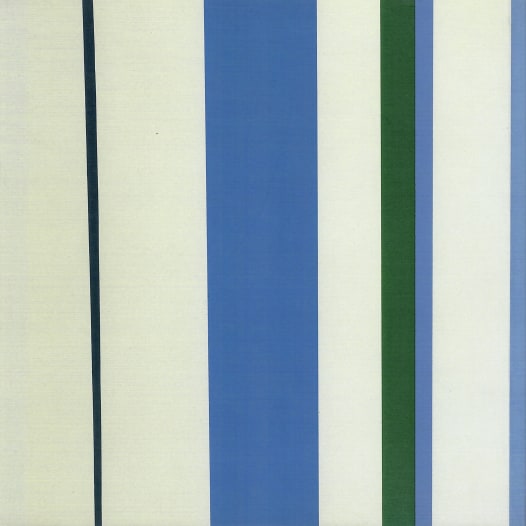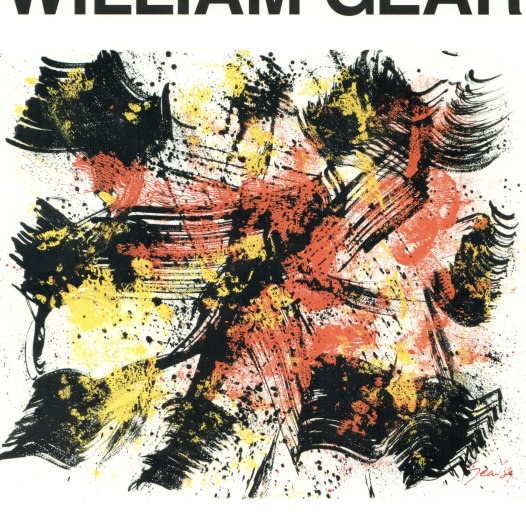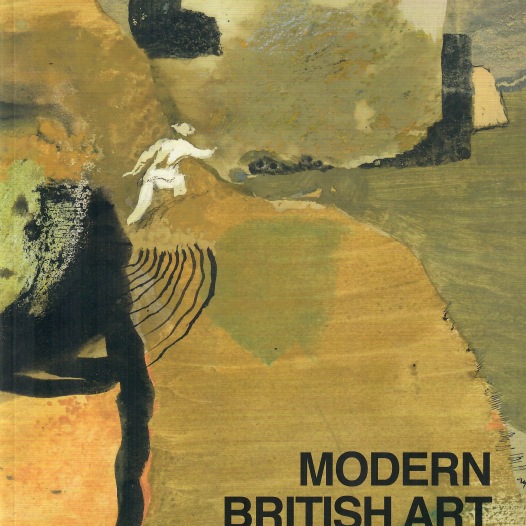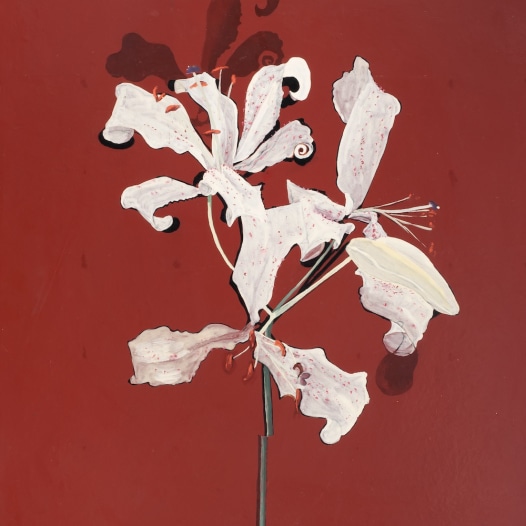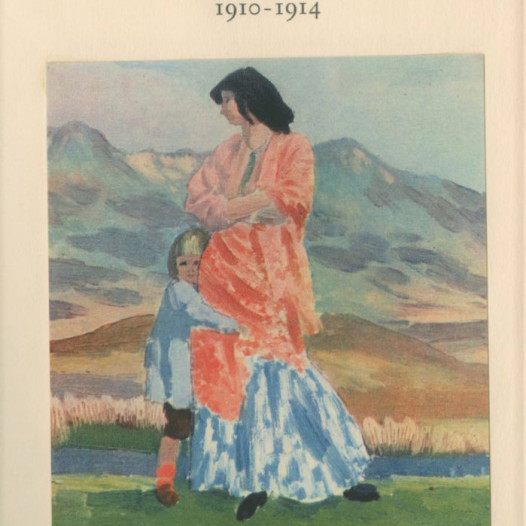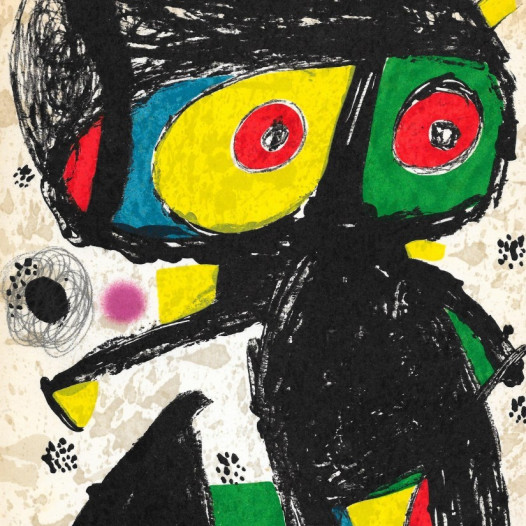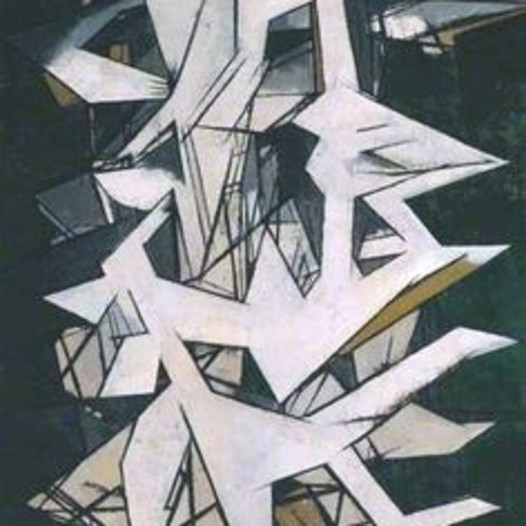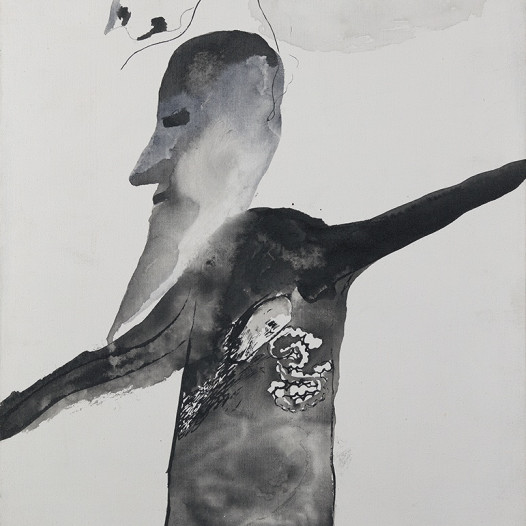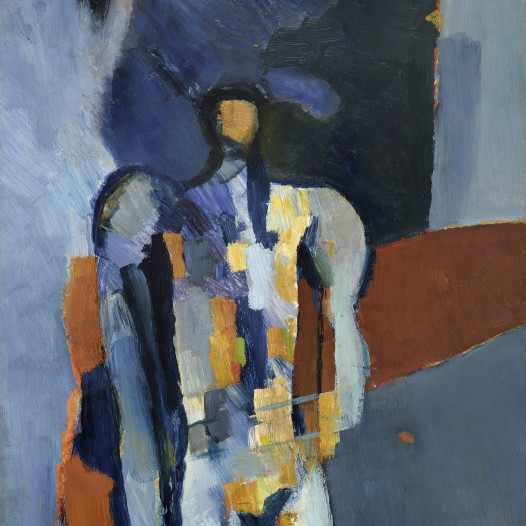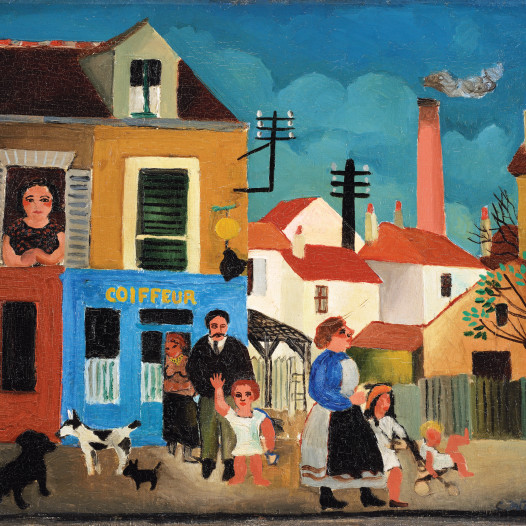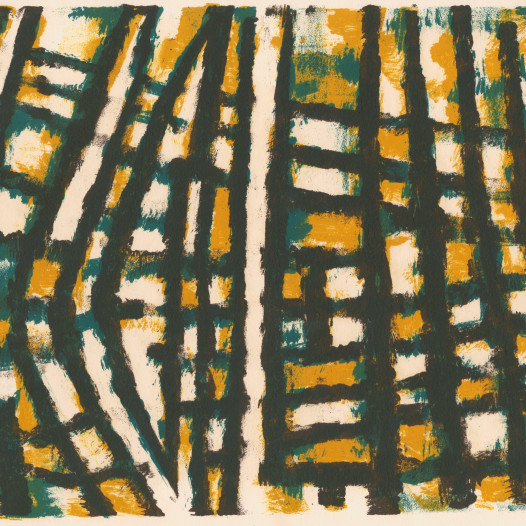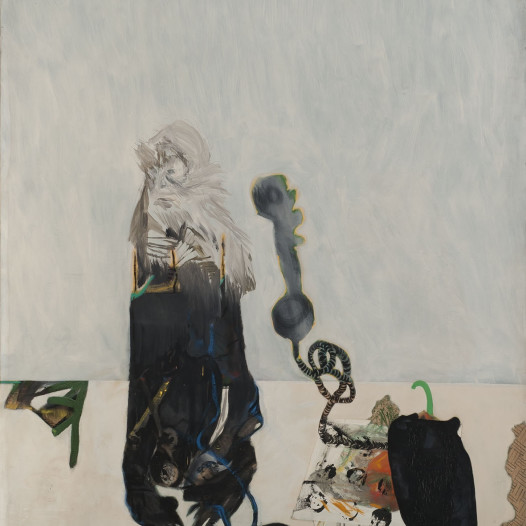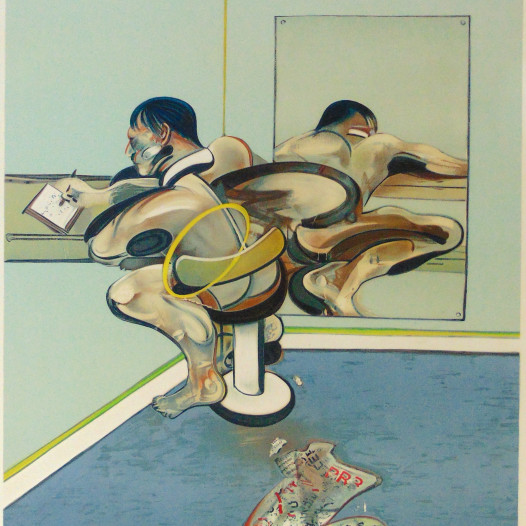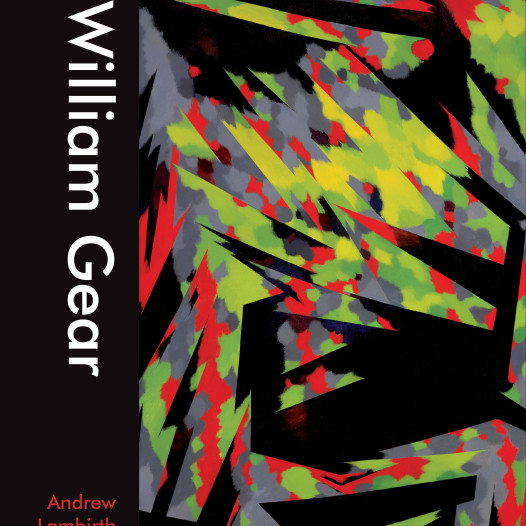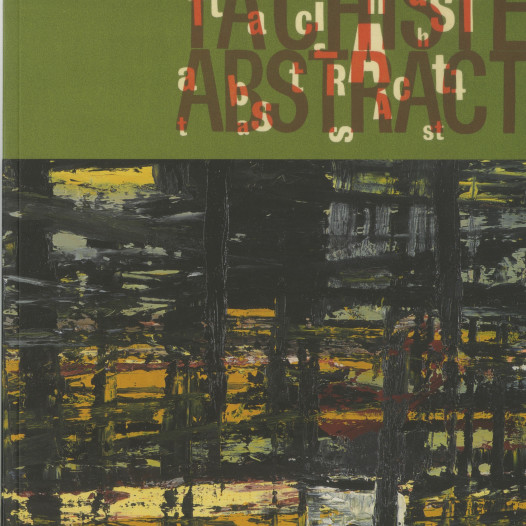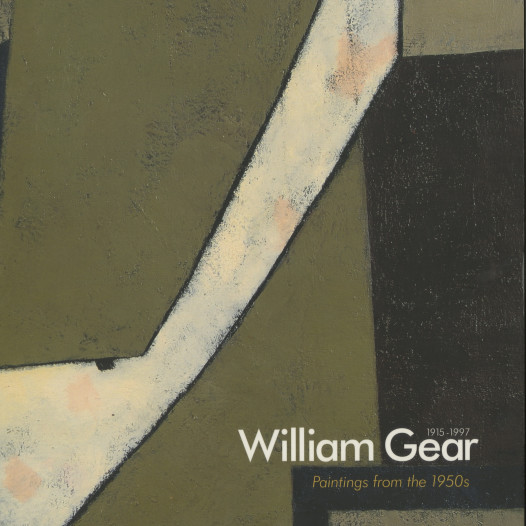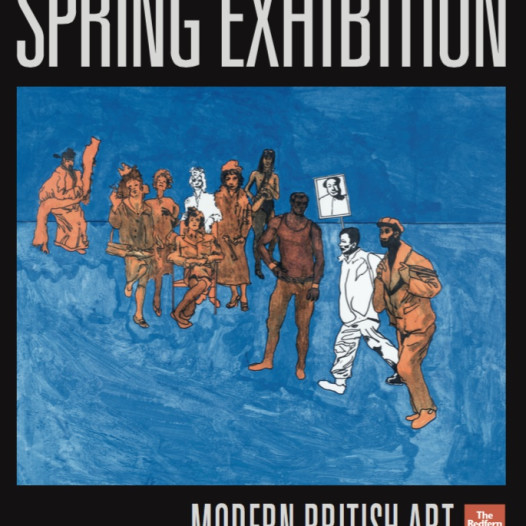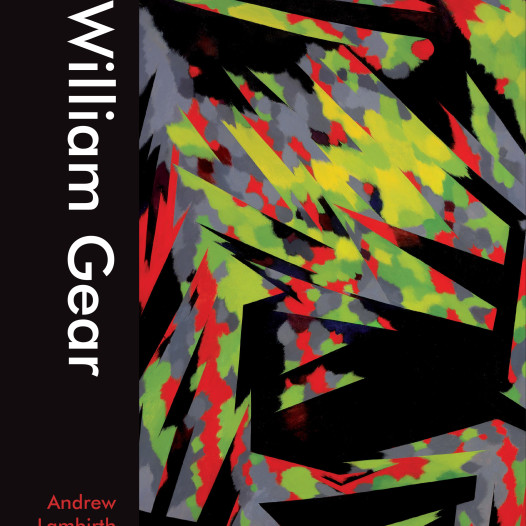William Gear RA
1915–1997Born in Fife, William Gear studied at Edinburgh College of Art from 1932, where teachers included SJ Peploe, and Wilhelmina Barns-Graham was among his peers. Upon graduating, he won a travelling scholarship, and studied under Fernand Léger in Paris. His early works depict bizarre structures in barren, post-apocalyptic landscapes, examples of which were shown in the first exhibition in Scotland of Surrealist art, in 1939. Called up in 1940, Gear met Merlyn Evans en-route to the Middle East, and Karl Otto Götz in Germany. He continued painting, staging solo exhibitions in Florence (1944) and Hamburg (1947). From 1945-47, Gear travelled to Germany (working as a Monuments Man), and from 1947-50, settled in Paris, befriending Jean-Michel Atlan, Alan Davie, Hans Hartung and Pierre Soulages, among others. His work grew more abstract, with irrational shapes and a bold palette, which prompted his friend Stephen Gilbert to introduce Gear to CoBrA, allowing him to exhibit in important early CoBrA shows in Copenhagen and in Amsterdam, in 1949. Later that year, Gear’s paintings were recommended to Betty Parsons, a prominent New York dealer and champion of Modernism, who arranged for a joint-exhibition with Jackson Pollock. This was the first time his work was shown in America, and Gear was the only non-American who Pollock shared an exhibition with. However, the New York show failed to launch Gear in America.
In the summer of 1950, Gear stayed in Doëlan, in south Finistère, drawing and painting marine subjects. Later that year, he moved to Buckinghamshire with his new wife, where the abstracted fall of light glimpsed through tangled trees manifested itself in large, painterly canvases. A famous example is Autumn Landscape, painted for the 1951 Festival of Britain. Arts Council judges awarded it a prize of £500, but its abstract nature, and the fact it received government money as part of the prize, caused great controversy. The press and public (as well as artists, including Laura Knight) were outraged; the Daily Mail ran the story as front-page news, and a large reproduction of the painting appeared in the Daily Telegraph. The letter-pages of the newspapers were filled for the next month with angry responses, and the painting was even discussed in Parliament, on 3 May. It provoked such an outcry that this was the only prize-winning painting not to enter a public collection by the end of the year.
Undeterred, Gear pioneered the technique of silkscreen, and was one of the first British artists to exhibit these prints as artworks, in a mixed show at the Redfern Gallery in 1953. He also represented Britain at the 1952 São Paulo Bienale; shared exhibitions with Ivon Hitchens in London (1954) and with Sandra Blow in New York (1957); while examples of his work featured in important British Council touring shows, including Seven British Artists, in 1959. In 1958, Gear was appointed curator of Towner Art Gallery in Eastbourne. However, the local community was resistant to the Modernist art championed by Gear, and every purchase had to overcome fierce opposition. He later said of this time that "I won the battle, I was a casualty if you like, but I won the battle". In 1960, two paintings by Gear were included in the Royal Academy Summer Exhibition - the first abstract works ever to be shown at the Academy, and which were met with much derision in the press. At the 1962 Summer Exhibition, his submissions were rejected by the RA Hanging Committee, prompting the sculptor FE McWilliam to resign in protest.
Depressed by the constant opposition to his purchases, Gear left Eastbourne in 1964, and started teaching at Birmingham College of Arts and Crafts (until 1975), where his students included Brendan Neiland. In this period, Gear painted dynamic, diagonal black armatures against vibrant detonations of colour, perfecting a new, thrilling evocation of light pulsing through foliage. From the 1970s onwards, the armatures no longer symbolised tree trunks, but jagged and irregular metal off-cuts, though the harsh forms were often complemented by warm tasches of colour. These years also saw him painting softer, more rounded shapes in amongst the hard edges. He was made a Senior Royal Academician aged eighty, some three decades after first exhibiting at the RA. In February 1997, the Redfern Gallery’s Golden Jubilee Exhibition, celebrating fifty years of Gear’s output, became a memorial show, with Gear having died just two days after the opening. For his centenary year, a major retrospective was staged at Towner, and toured to City Art Centre, Edinburgh, during 2015-16. It received widespread critical acclaim.
William Gear's estate is represented by the Redfern Gallery.
Works
-
 William Gear RACappadocia No. 2, 1989Monotype, ink and acrylic on paper40 x 56 cmSigned and dated lower right; titled verso%3Cdiv%20class%3D%22artist%22%3E%3Cspan%20class%3D%22artist%22%3E%3Cstrong%3EWilliam%20Gear%20RA%3C/strong%3E%3C/span%3E%3C/div%3E%0D%3Cdiv%20class%3D%22title%22%3E%3Cem%3ECappadocia%20No.%202%3C/em%3E%2C%201989%3C/div%3E%0D%3Cdiv%20class%3D%22signed_and_dated%22%3ESigned%20and%20dated%20lower%20right%3B%20titled%20verso%3C/div%3E%0D%3Cdiv%20class%3D%22medium%22%3EMonotype%2C%20ink%20and%20acrylic%20on%20paper%3C/div%3E%0D%3Cdiv%20class%3D%22dimensions%22%3E40%20x%2056%20cm%3C/div%3E
William Gear RACappadocia No. 2, 1989Monotype, ink and acrylic on paper40 x 56 cmSigned and dated lower right; titled verso%3Cdiv%20class%3D%22artist%22%3E%3Cspan%20class%3D%22artist%22%3E%3Cstrong%3EWilliam%20Gear%20RA%3C/strong%3E%3C/span%3E%3C/div%3E%0D%3Cdiv%20class%3D%22title%22%3E%3Cem%3ECappadocia%20No.%202%3C/em%3E%2C%201989%3C/div%3E%0D%3Cdiv%20class%3D%22signed_and_dated%22%3ESigned%20and%20dated%20lower%20right%3B%20titled%20verso%3C/div%3E%0D%3Cdiv%20class%3D%22medium%22%3EMonotype%2C%20ink%20and%20acrylic%20on%20paper%3C/div%3E%0D%3Cdiv%20class%3D%22dimensions%22%3E40%20x%2056%20cm%3C/div%3E -
 William Gear RAAutumn Garden, 1983Oil on canvas152 x 122 cmSigned and dated lower right; titled verso%3Cdiv%20class%3D%22artist%22%3E%3Cspan%20class%3D%22artist%22%3E%3Cstrong%3EWilliam%20Gear%20RA%3C/strong%3E%3C/span%3E%3C/div%3E%0D%3Cdiv%20class%3D%22title%22%3E%3Cem%3EAutumn%20Garden%3C/em%3E%2C%201983%3C/div%3E%0D%3Cdiv%20class%3D%22signed_and_dated%22%3ESigned%20and%20dated%20lower%20right%3B%20titled%20verso%3C/div%3E%0D%3Cdiv%20class%3D%22medium%22%3EOil%20on%20canvas%3C/div%3E%0D%3Cdiv%20class%3D%22dimensions%22%3E152%20x%20122%20cm%3C/div%3E
William Gear RAAutumn Garden, 1983Oil on canvas152 x 122 cmSigned and dated lower right; titled verso%3Cdiv%20class%3D%22artist%22%3E%3Cspan%20class%3D%22artist%22%3E%3Cstrong%3EWilliam%20Gear%20RA%3C/strong%3E%3C/span%3E%3C/div%3E%0D%3Cdiv%20class%3D%22title%22%3E%3Cem%3EAutumn%20Garden%3C/em%3E%2C%201983%3C/div%3E%0D%3Cdiv%20class%3D%22signed_and_dated%22%3ESigned%20and%20dated%20lower%20right%3B%20titled%20verso%3C/div%3E%0D%3Cdiv%20class%3D%22medium%22%3EOil%20on%20canvas%3C/div%3E%0D%3Cdiv%20class%3D%22dimensions%22%3E152%20x%20122%20cm%3C/div%3E -
 William Gear RASantorini, 1982Acrylic on paper36 x 57 cmSigned and dated lower right; titled verso%3Cdiv%20class%3D%22artist%22%3E%3Cspan%20class%3D%22artist%22%3E%3Cstrong%3EWilliam%20Gear%20RA%3C/strong%3E%3C/span%3E%3C/div%3E%0D%3Cdiv%20class%3D%22title%22%3E%3Cem%3ESantorini%3C/em%3E%2C%201982%3C/div%3E%0D%3Cdiv%20class%3D%22signed_and_dated%22%3ESigned%20and%20dated%20lower%20right%3B%20titled%20verso%3C/div%3E%0D%3Cdiv%20class%3D%22medium%22%3EAcrylic%20on%20paper%3C/div%3E%0D%3Cdiv%20class%3D%22dimensions%22%3E36%20x%2057%20cm%3C/div%3E
William Gear RASantorini, 1982Acrylic on paper36 x 57 cmSigned and dated lower right; titled verso%3Cdiv%20class%3D%22artist%22%3E%3Cspan%20class%3D%22artist%22%3E%3Cstrong%3EWilliam%20Gear%20RA%3C/strong%3E%3C/span%3E%3C/div%3E%0D%3Cdiv%20class%3D%22title%22%3E%3Cem%3ESantorini%3C/em%3E%2C%201982%3C/div%3E%0D%3Cdiv%20class%3D%22signed_and_dated%22%3ESigned%20and%20dated%20lower%20right%3B%20titled%20verso%3C/div%3E%0D%3Cdiv%20class%3D%22medium%22%3EAcrylic%20on%20paper%3C/div%3E%0D%3Cdiv%20class%3D%22dimensions%22%3E36%20x%2057%20cm%3C/div%3E -
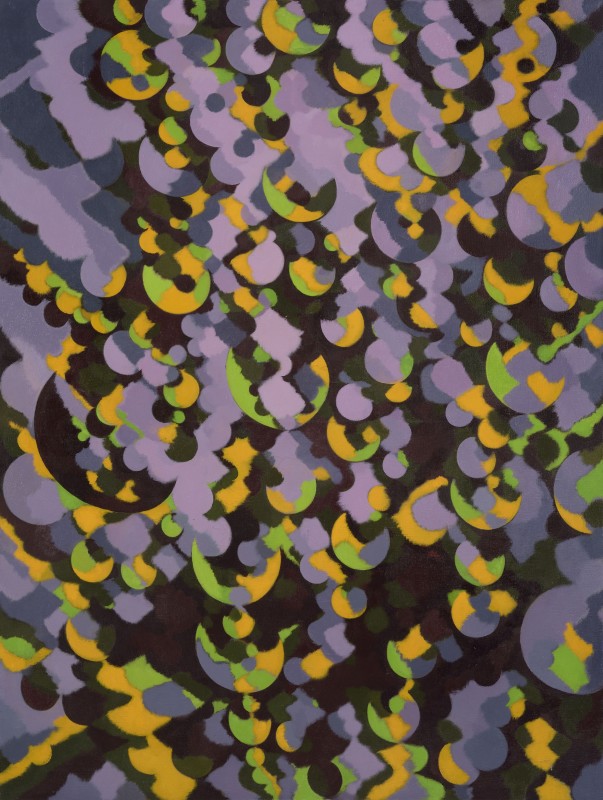 William Gear RASpring Frolic, 1975Oil on canvas122 x 92 cmSigned, dated and titled verso%3Cdiv%20class%3D%22artist%22%3E%3Cspan%20class%3D%22artist%22%3E%3Cstrong%3EWilliam%20Gear%20RA%3C/strong%3E%3C/span%3E%3C/div%3E%0D%3Cdiv%20class%3D%22title%22%3E%3Cem%3ESpring%20Frolic%3C/em%3E%2C%201975%3C/div%3E%0D%3Cdiv%20class%3D%22signed_and_dated%22%3ESigned%2C%20dated%20and%20titled%20verso%3C/div%3E%0D%3Cdiv%20class%3D%22medium%22%3EOil%20on%20canvas%3C/div%3E%0D%3Cdiv%20class%3D%22dimensions%22%3E122%20x%2092%20cm%3C/div%3E
William Gear RASpring Frolic, 1975Oil on canvas122 x 92 cmSigned, dated and titled verso%3Cdiv%20class%3D%22artist%22%3E%3Cspan%20class%3D%22artist%22%3E%3Cstrong%3EWilliam%20Gear%20RA%3C/strong%3E%3C/span%3E%3C/div%3E%0D%3Cdiv%20class%3D%22title%22%3E%3Cem%3ESpring%20Frolic%3C/em%3E%2C%201975%3C/div%3E%0D%3Cdiv%20class%3D%22signed_and_dated%22%3ESigned%2C%20dated%20and%20titled%20verso%3C/div%3E%0D%3Cdiv%20class%3D%22medium%22%3EOil%20on%20canvas%3C/div%3E%0D%3Cdiv%20class%3D%22dimensions%22%3E122%20x%2092%20cm%3C/div%3E -
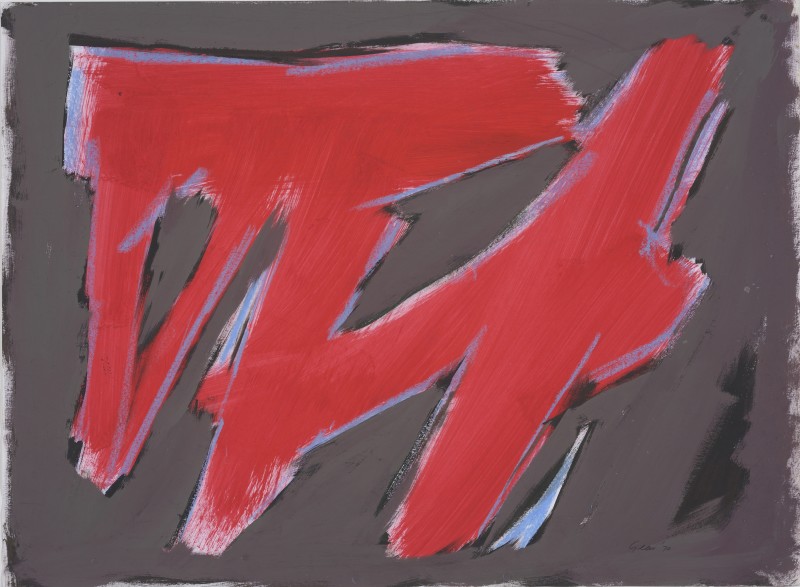 William Gear RARed Feature, 1970Acrylic and pastel on paper56 x 76 cmSigned and dated lower right; titled verso%3Cdiv%20class%3D%22artist%22%3E%3Cspan%20class%3D%22artist%22%3E%3Cstrong%3EWilliam%20Gear%20RA%3C/strong%3E%3C/span%3E%3C/div%3E%0D%3Cdiv%20class%3D%22title%22%3E%3Cem%3ERed%20Feature%3C/em%3E%2C%201970%3C/div%3E%0D%3Cdiv%20class%3D%22signed_and_dated%22%3ESigned%20and%20dated%20lower%20right%3B%20titled%20verso%3C/div%3E%0D%3Cdiv%20class%3D%22medium%22%3EAcrylic%20and%20pastel%20on%20paper%3C/div%3E%0D%3Cdiv%20class%3D%22dimensions%22%3E56%20x%2076%20cm%3C/div%3E
William Gear RARed Feature, 1970Acrylic and pastel on paper56 x 76 cmSigned and dated lower right; titled verso%3Cdiv%20class%3D%22artist%22%3E%3Cspan%20class%3D%22artist%22%3E%3Cstrong%3EWilliam%20Gear%20RA%3C/strong%3E%3C/span%3E%3C/div%3E%0D%3Cdiv%20class%3D%22title%22%3E%3Cem%3ERed%20Feature%3C/em%3E%2C%201970%3C/div%3E%0D%3Cdiv%20class%3D%22signed_and_dated%22%3ESigned%20and%20dated%20lower%20right%3B%20titled%20verso%3C/div%3E%0D%3Cdiv%20class%3D%22medium%22%3EAcrylic%20and%20pastel%20on%20paper%3C/div%3E%0D%3Cdiv%20class%3D%22dimensions%22%3E56%20x%2076%20cm%3C/div%3E -
 William Gear RASouvenir, 1969Screenprint46 x 29 cm (sheet: 58 x 39 cm)From the edition of 20 impressionsSigned, dated, titled, and numbered%3Cdiv%20class%3D%22artist%22%3E%3Cspan%20class%3D%22artist%22%3E%3Cstrong%3EWilliam%20Gear%20RA%3C/strong%3E%3C/span%3E%3C/div%3E%0D%3Cdiv%20class%3D%22title%22%3E%3Cem%3ESouvenir%3C/em%3E%2C%201969%3C/div%3E%0D%3Cdiv%20class%3D%22signed_and_dated%22%3ESigned%2C%20dated%2C%20titled%2C%20and%20numbered%3C/div%3E%0D%3Cdiv%20class%3D%22medium%22%3EScreenprint%20%3C/div%3E%0D%3Cdiv%20class%3D%22dimensions%22%3E46%20x%2029%20cm%20%28sheet%3A%2058%20x%2039%20cm%29%3C/div%3E%0D%3Cdiv%20class%3D%22edition_details%22%3EFrom%20the%20edition%20of%2020%20impressions%3C/div%3E
William Gear RASouvenir, 1969Screenprint46 x 29 cm (sheet: 58 x 39 cm)From the edition of 20 impressionsSigned, dated, titled, and numbered%3Cdiv%20class%3D%22artist%22%3E%3Cspan%20class%3D%22artist%22%3E%3Cstrong%3EWilliam%20Gear%20RA%3C/strong%3E%3C/span%3E%3C/div%3E%0D%3Cdiv%20class%3D%22title%22%3E%3Cem%3ESouvenir%3C/em%3E%2C%201969%3C/div%3E%0D%3Cdiv%20class%3D%22signed_and_dated%22%3ESigned%2C%20dated%2C%20titled%2C%20and%20numbered%3C/div%3E%0D%3Cdiv%20class%3D%22medium%22%3EScreenprint%20%3C/div%3E%0D%3Cdiv%20class%3D%22dimensions%22%3E46%20x%2029%20cm%20%28sheet%3A%2058%20x%2039%20cm%29%3C/div%3E%0D%3Cdiv%20class%3D%22edition_details%22%3EFrom%20the%20edition%20of%2020%20impressions%3C/div%3E -
 William Gear RASpring Landscape, 1967Oil on canvas183 x 122 cmSigned and dated lower right; titled verso%3Cdiv%20class%3D%22artist%22%3E%3Cspan%20class%3D%22artist%22%3E%3Cstrong%3EWilliam%20Gear%20RA%3C/strong%3E%3C/span%3E%3C/div%3E%0D%3Cdiv%20class%3D%22title%22%3E%3Cem%3ESpring%20Landscape%3C/em%3E%2C%201967%3C/div%3E%0D%3Cdiv%20class%3D%22signed_and_dated%22%3ESigned%20and%20dated%20lower%20right%3B%20titled%20verso%3C/div%3E%0D%3Cdiv%20class%3D%22medium%22%3EOil%20on%20canvas%3C/div%3E%0D%3Cdiv%20class%3D%22dimensions%22%3E183%20x%20122%20cm%3C/div%3E
William Gear RASpring Landscape, 1967Oil on canvas183 x 122 cmSigned and dated lower right; titled verso%3Cdiv%20class%3D%22artist%22%3E%3Cspan%20class%3D%22artist%22%3E%3Cstrong%3EWilliam%20Gear%20RA%3C/strong%3E%3C/span%3E%3C/div%3E%0D%3Cdiv%20class%3D%22title%22%3E%3Cem%3ESpring%20Landscape%3C/em%3E%2C%201967%3C/div%3E%0D%3Cdiv%20class%3D%22signed_and_dated%22%3ESigned%20and%20dated%20lower%20right%3B%20titled%20verso%3C/div%3E%0D%3Cdiv%20class%3D%22medium%22%3EOil%20on%20canvas%3C/div%3E%0D%3Cdiv%20class%3D%22dimensions%22%3E183%20x%20122%20cm%3C/div%3E -
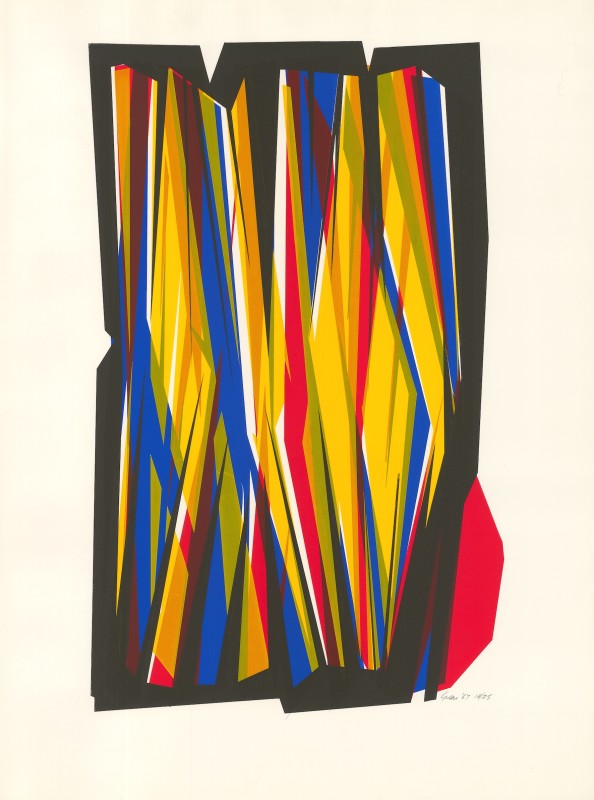 William Gear RASummer Stripes, 1967Screenprint65 x 40 cm (sheet: 79 x 58 cm)From the edition of 25 impressionsSigned, dated and numbered%3Cdiv%20class%3D%22artist%22%3E%3Cspan%20class%3D%22artist%22%3E%3Cstrong%3EWilliam%20Gear%20RA%3C/strong%3E%3C/span%3E%3C/div%3E%0D%3Cdiv%20class%3D%22title%22%3E%3Cem%3ESummer%20Stripes%3C/em%3E%2C%201967%3C/div%3E%0D%3Cdiv%20class%3D%22signed_and_dated%22%3ESigned%2C%20dated%20and%20numbered%3C/div%3E%0D%3Cdiv%20class%3D%22medium%22%3EScreenprint%3C/div%3E%0D%3Cdiv%20class%3D%22dimensions%22%3E65%20x%2040%20cm%20%28sheet%3A%2079%20x%2058%20cm%29%3C/div%3E%0D%3Cdiv%20class%3D%22edition_details%22%3EFrom%20the%20edition%20of%2025%20impressions%3C/div%3E
William Gear RASummer Stripes, 1967Screenprint65 x 40 cm (sheet: 79 x 58 cm)From the edition of 25 impressionsSigned, dated and numbered%3Cdiv%20class%3D%22artist%22%3E%3Cspan%20class%3D%22artist%22%3E%3Cstrong%3EWilliam%20Gear%20RA%3C/strong%3E%3C/span%3E%3C/div%3E%0D%3Cdiv%20class%3D%22title%22%3E%3Cem%3ESummer%20Stripes%3C/em%3E%2C%201967%3C/div%3E%0D%3Cdiv%20class%3D%22signed_and_dated%22%3ESigned%2C%20dated%20and%20numbered%3C/div%3E%0D%3Cdiv%20class%3D%22medium%22%3EScreenprint%3C/div%3E%0D%3Cdiv%20class%3D%22dimensions%22%3E65%20x%2040%20cm%20%28sheet%3A%2079%20x%2058%20cm%29%3C/div%3E%0D%3Cdiv%20class%3D%22edition_details%22%3EFrom%20the%20edition%20of%2025%20impressions%3C/div%3E -
 William Gear RAUntitled, 1966Pastel on paper38 x 56 cmSigned and dated lower right%3Cdiv%20class%3D%22artist%22%3E%3Cspan%20class%3D%22artist%22%3E%3Cstrong%3EWilliam%20Gear%20RA%3C/strong%3E%3C/span%3E%3C/div%3E%0D%3Cdiv%20class%3D%22title%22%3E%3Cem%3EUntitled%3C/em%3E%2C%201966%3C/div%3E%0D%3Cdiv%20class%3D%22signed_and_dated%22%3ESigned%20and%20dated%20lower%20right%3C/div%3E%0D%3Cdiv%20class%3D%22medium%22%3EPastel%20on%20paper%3C/div%3E%0D%3Cdiv%20class%3D%22dimensions%22%3E38%20x%2056%20cm%3C/div%3E
William Gear RAUntitled, 1966Pastel on paper38 x 56 cmSigned and dated lower right%3Cdiv%20class%3D%22artist%22%3E%3Cspan%20class%3D%22artist%22%3E%3Cstrong%3EWilliam%20Gear%20RA%3C/strong%3E%3C/span%3E%3C/div%3E%0D%3Cdiv%20class%3D%22title%22%3E%3Cem%3EUntitled%3C/em%3E%2C%201966%3C/div%3E%0D%3Cdiv%20class%3D%22signed_and_dated%22%3ESigned%20and%20dated%20lower%20right%3C/div%3E%0D%3Cdiv%20class%3D%22medium%22%3EPastel%20on%20paper%3C/div%3E%0D%3Cdiv%20class%3D%22dimensions%22%3E38%20x%2056%20cm%3C/div%3E -
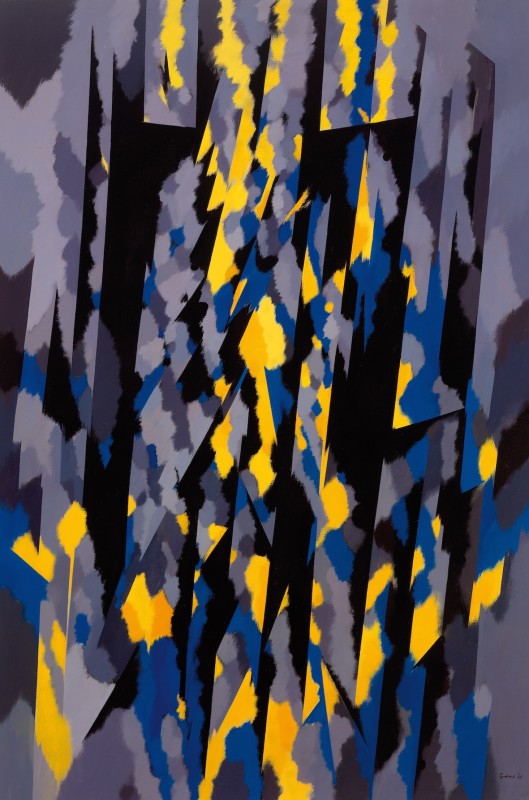 William Gear RAWinter Structure, 1965Oil on canvas183 x 122 cmSigned and dated lower right; titled verso%3Cdiv%20class%3D%22artist%22%3E%3Cspan%20class%3D%22artist%22%3E%3Cstrong%3EWilliam%20Gear%20RA%3C/strong%3E%3C/span%3E%3C/div%3E%0D%3Cdiv%20class%3D%22title%22%3E%3Cem%3EWinter%20Structure%3C/em%3E%2C%201965%3C/div%3E%0D%3Cdiv%20class%3D%22signed_and_dated%22%3ESigned%20and%20dated%20lower%20right%3B%20titled%20verso%3C/div%3E%0D%3Cdiv%20class%3D%22medium%22%3EOil%20on%20canvas%3C/div%3E%0D%3Cdiv%20class%3D%22dimensions%22%3E183%20x%20122%20cm%3C/div%3E
William Gear RAWinter Structure, 1965Oil on canvas183 x 122 cmSigned and dated lower right; titled verso%3Cdiv%20class%3D%22artist%22%3E%3Cspan%20class%3D%22artist%22%3E%3Cstrong%3EWilliam%20Gear%20RA%3C/strong%3E%3C/span%3E%3C/div%3E%0D%3Cdiv%20class%3D%22title%22%3E%3Cem%3EWinter%20Structure%3C/em%3E%2C%201965%3C/div%3E%0D%3Cdiv%20class%3D%22signed_and_dated%22%3ESigned%20and%20dated%20lower%20right%3B%20titled%20verso%3C/div%3E%0D%3Cdiv%20class%3D%22medium%22%3EOil%20on%20canvas%3C/div%3E%0D%3Cdiv%20class%3D%22dimensions%22%3E183%20x%20122%20cm%3C/div%3E -
 William Gear RAWinter Landscape, 1963Oil on canvas122 x 81 cmSigned and dated lower right; titled verso%3Cdiv%20class%3D%22artist%22%3E%3Cspan%20class%3D%22artist%22%3E%3Cstrong%3EWilliam%20Gear%20RA%3C/strong%3E%3C/span%3E%3C/div%3E%0D%3Cdiv%20class%3D%22title%22%3E%3Cem%3EWinter%20Landscape%3C/em%3E%2C%201963%3C/div%3E%0D%3Cdiv%20class%3D%22signed_and_dated%22%3ESigned%20and%20dated%20lower%20right%3B%20titled%20verso%3C/div%3E%0D%3Cdiv%20class%3D%22medium%22%3EOil%20on%20canvas%3C/div%3E%0D%3Cdiv%20class%3D%22dimensions%22%3E122%20x%2081%20cm%3C/div%3E
William Gear RAWinter Landscape, 1963Oil on canvas122 x 81 cmSigned and dated lower right; titled verso%3Cdiv%20class%3D%22artist%22%3E%3Cspan%20class%3D%22artist%22%3E%3Cstrong%3EWilliam%20Gear%20RA%3C/strong%3E%3C/span%3E%3C/div%3E%0D%3Cdiv%20class%3D%22title%22%3E%3Cem%3EWinter%20Landscape%3C/em%3E%2C%201963%3C/div%3E%0D%3Cdiv%20class%3D%22signed_and_dated%22%3ESigned%20and%20dated%20lower%20right%3B%20titled%20verso%3C/div%3E%0D%3Cdiv%20class%3D%22medium%22%3EOil%20on%20canvas%3C/div%3E%0D%3Cdiv%20class%3D%22dimensions%22%3E122%20x%2081%20cm%3C/div%3E -
 William Gear RABlack Delight, 1962Ink on paper53 x 74 cmSigned and dated lower right; titled verso%3Cdiv%20class%3D%22artist%22%3E%3Cspan%20class%3D%22artist%22%3E%3Cstrong%3EWilliam%20Gear%20RA%3C/strong%3E%3C/span%3E%3C/div%3E%0D%3Cdiv%20class%3D%22title%22%3E%3Cem%3EBlack%20Delight%3C/em%3E%2C%201962%3C/div%3E%0D%3Cdiv%20class%3D%22signed_and_dated%22%3ESigned%20and%20dated%20lower%20right%3B%20titled%20verso%3C/div%3E%0D%3Cdiv%20class%3D%22medium%22%3EInk%20on%20paper%3C/div%3E%0D%3Cdiv%20class%3D%22dimensions%22%3E53%20x%2074%20cm%3C/div%3E
William Gear RABlack Delight, 1962Ink on paper53 x 74 cmSigned and dated lower right; titled verso%3Cdiv%20class%3D%22artist%22%3E%3Cspan%20class%3D%22artist%22%3E%3Cstrong%3EWilliam%20Gear%20RA%3C/strong%3E%3C/span%3E%3C/div%3E%0D%3Cdiv%20class%3D%22title%22%3E%3Cem%3EBlack%20Delight%3C/em%3E%2C%201962%3C/div%3E%0D%3Cdiv%20class%3D%22signed_and_dated%22%3ESigned%20and%20dated%20lower%20right%3B%20titled%20verso%3C/div%3E%0D%3Cdiv%20class%3D%22medium%22%3EInk%20on%20paper%3C/div%3E%0D%3Cdiv%20class%3D%22dimensions%22%3E53%20x%2074%20cm%3C/div%3E -
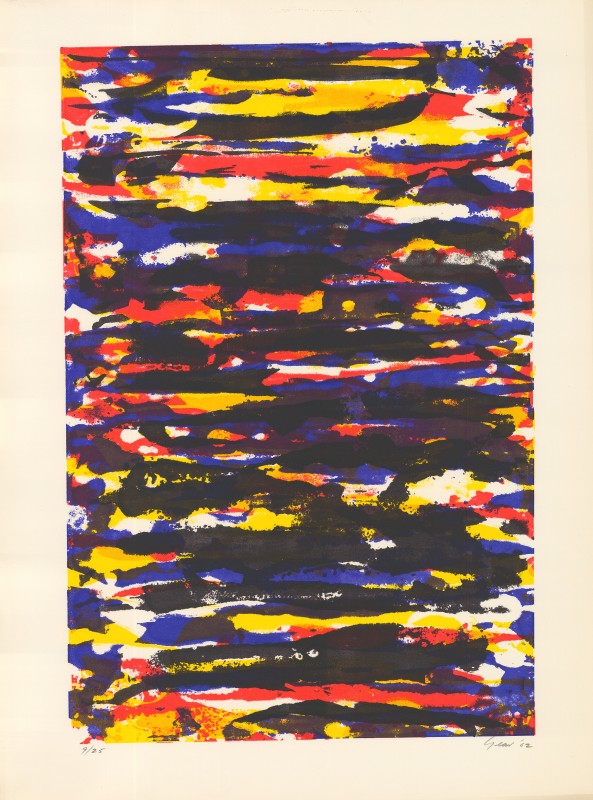 William Gear RACoast, 1962Screenprint66 x 44 cm (sheet: 76 x 56 cm)From the edition of 25 impressionsSigned, dated and numbered%3Cdiv%20class%3D%22artist%22%3E%3Cspan%20class%3D%22artist%22%3E%3Cstrong%3EWilliam%20Gear%20RA%3C/strong%3E%3C/span%3E%3C/div%3E%0D%3Cdiv%20class%3D%22title%22%3E%3Cem%3ECoast%3C/em%3E%2C%201962%3C/div%3E%0D%3Cdiv%20class%3D%22signed_and_dated%22%3ESigned%2C%20dated%20and%20numbered%3C/div%3E%0D%3Cdiv%20class%3D%22medium%22%3EScreenprint%3C/div%3E%0D%3Cdiv%20class%3D%22dimensions%22%3E66%20x%2044%20cm%20%28sheet%3A%2076%20x%2056%20cm%29%20%3C/div%3E%0D%3Cdiv%20class%3D%22edition_details%22%3EFrom%20the%20edition%20of%2025%20impressions%3C/div%3E
William Gear RACoast, 1962Screenprint66 x 44 cm (sheet: 76 x 56 cm)From the edition of 25 impressionsSigned, dated and numbered%3Cdiv%20class%3D%22artist%22%3E%3Cspan%20class%3D%22artist%22%3E%3Cstrong%3EWilliam%20Gear%20RA%3C/strong%3E%3C/span%3E%3C/div%3E%0D%3Cdiv%20class%3D%22title%22%3E%3Cem%3ECoast%3C/em%3E%2C%201962%3C/div%3E%0D%3Cdiv%20class%3D%22signed_and_dated%22%3ESigned%2C%20dated%20and%20numbered%3C/div%3E%0D%3Cdiv%20class%3D%22medium%22%3EScreenprint%3C/div%3E%0D%3Cdiv%20class%3D%22dimensions%22%3E66%20x%2044%20cm%20%28sheet%3A%2076%20x%2056%20cm%29%20%3C/div%3E%0D%3Cdiv%20class%3D%22edition_details%22%3EFrom%20the%20edition%20of%2025%20impressions%3C/div%3E -
 William Gear RASpring Landscape, 1962Screenprint70 x 46 cm (sheet: 79 x 58 cm)From the edition of 25 impressionsSigned, dated and numbered%3Cdiv%20class%3D%22artist%22%3E%3Cspan%20class%3D%22artist%22%3E%3Cstrong%3EWilliam%20Gear%20RA%3C/strong%3E%3C/span%3E%3C/div%3E%0D%3Cdiv%20class%3D%22title%22%3E%3Cem%3ESpring%20Landscape%3C/em%3E%2C%201962%3C/div%3E%0D%3Cdiv%20class%3D%22signed_and_dated%22%3ESigned%2C%20dated%20and%20numbered%3C/div%3E%0D%3Cdiv%20class%3D%22medium%22%3EScreenprint%3C/div%3E%0D%3Cdiv%20class%3D%22dimensions%22%3E70%20x%2046%20cm%20%28sheet%3A%2079%20x%2058%20cm%29%3C/div%3E%0D%3Cdiv%20class%3D%22edition_details%22%3EFrom%20the%20edition%20of%2025%20impressions%3C/div%3E
William Gear RASpring Landscape, 1962Screenprint70 x 46 cm (sheet: 79 x 58 cm)From the edition of 25 impressionsSigned, dated and numbered%3Cdiv%20class%3D%22artist%22%3E%3Cspan%20class%3D%22artist%22%3E%3Cstrong%3EWilliam%20Gear%20RA%3C/strong%3E%3C/span%3E%3C/div%3E%0D%3Cdiv%20class%3D%22title%22%3E%3Cem%3ESpring%20Landscape%3C/em%3E%2C%201962%3C/div%3E%0D%3Cdiv%20class%3D%22signed_and_dated%22%3ESigned%2C%20dated%20and%20numbered%3C/div%3E%0D%3Cdiv%20class%3D%22medium%22%3EScreenprint%3C/div%3E%0D%3Cdiv%20class%3D%22dimensions%22%3E70%20x%2046%20cm%20%28sheet%3A%2079%20x%2058%20cm%29%3C/div%3E%0D%3Cdiv%20class%3D%22edition_details%22%3EFrom%20the%20edition%20of%2025%20impressions%3C/div%3E -
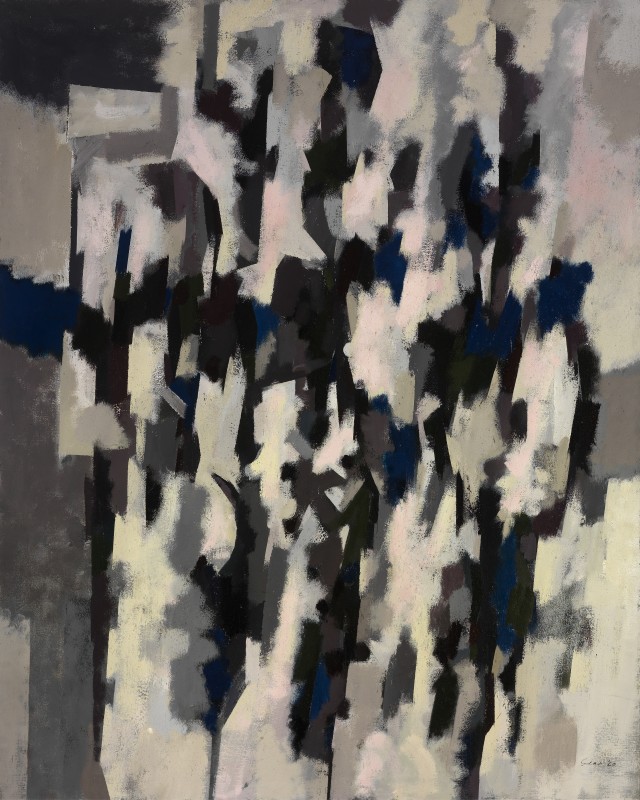 William Gear RALandscape Structure, 1960Oil on canvas152 x 122 cmSigned and dated lower right; signed, dated and titled verso%3Cdiv%20class%3D%22artist%22%3E%3Cspan%20class%3D%22artist%22%3E%3Cstrong%3EWilliam%20Gear%20RA%3C/strong%3E%3C/span%3E%3C/div%3E%0D%3Cdiv%20class%3D%22title%22%3E%3Cem%3ELandscape%20Structure%3C/em%3E%2C%201960%3C/div%3E%0D%3Cdiv%20class%3D%22signed_and_dated%22%3ESigned%20and%20dated%20lower%20right%3B%20signed%2C%20dated%20and%20titled%20verso%3C/div%3E%0D%3Cdiv%20class%3D%22medium%22%3EOil%20on%20canvas%3C/div%3E%0D%3Cdiv%20class%3D%22dimensions%22%3E152%20x%20122%20cm%3C/div%3E
William Gear RALandscape Structure, 1960Oil on canvas152 x 122 cmSigned and dated lower right; signed, dated and titled verso%3Cdiv%20class%3D%22artist%22%3E%3Cspan%20class%3D%22artist%22%3E%3Cstrong%3EWilliam%20Gear%20RA%3C/strong%3E%3C/span%3E%3C/div%3E%0D%3Cdiv%20class%3D%22title%22%3E%3Cem%3ELandscape%20Structure%3C/em%3E%2C%201960%3C/div%3E%0D%3Cdiv%20class%3D%22signed_and_dated%22%3ESigned%20and%20dated%20lower%20right%3B%20signed%2C%20dated%20and%20titled%20verso%3C/div%3E%0D%3Cdiv%20class%3D%22medium%22%3EOil%20on%20canvas%3C/div%3E%0D%3Cdiv%20class%3D%22dimensions%22%3E152%20x%20122%20cm%3C/div%3E -
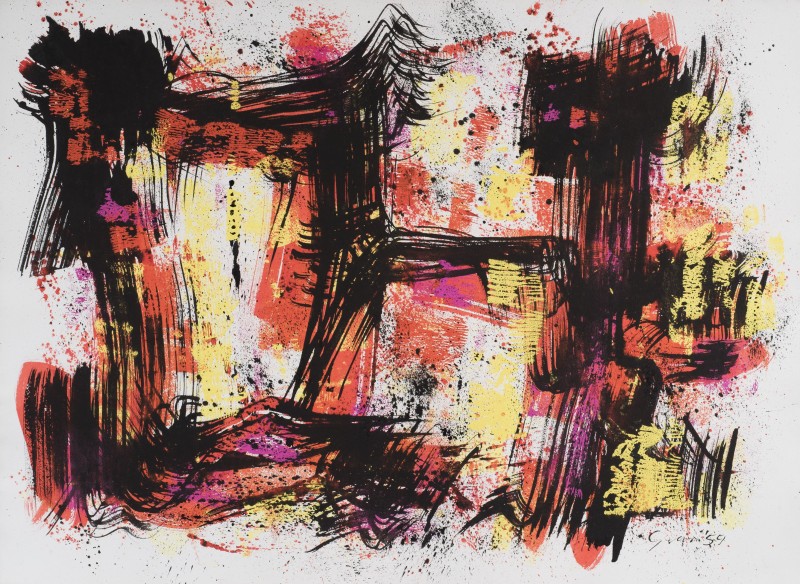 William Gear RAGouache, Dec '59, 1959Gouache and ink on paper50 x 62 cmSigned and dated lower right; titled verso%3Cdiv%20class%3D%22artist%22%3E%3Cspan%20class%3D%22artist%22%3E%3Cstrong%3EWilliam%20Gear%20RA%3C/strong%3E%3C/span%3E%3C/div%3E%0D%3Cdiv%20class%3D%22title%22%3E%3Cem%3EGouache%2C%20Dec%20%2759%3C/em%3E%2C%201959%3C/div%3E%0D%3Cdiv%20class%3D%22signed_and_dated%22%3ESigned%20and%20dated%20lower%20right%3B%20titled%20verso%3C/div%3E%0D%3Cdiv%20class%3D%22medium%22%3EGouache%20and%20ink%20on%20paper%3C/div%3E%0D%3Cdiv%20class%3D%22dimensions%22%3E50%20x%2062%20cm%3C/div%3E
William Gear RAGouache, Dec '59, 1959Gouache and ink on paper50 x 62 cmSigned and dated lower right; titled verso%3Cdiv%20class%3D%22artist%22%3E%3Cspan%20class%3D%22artist%22%3E%3Cstrong%3EWilliam%20Gear%20RA%3C/strong%3E%3C/span%3E%3C/div%3E%0D%3Cdiv%20class%3D%22title%22%3E%3Cem%3EGouache%2C%20Dec%20%2759%3C/em%3E%2C%201959%3C/div%3E%0D%3Cdiv%20class%3D%22signed_and_dated%22%3ESigned%20and%20dated%20lower%20right%3B%20titled%20verso%3C/div%3E%0D%3Cdiv%20class%3D%22medium%22%3EGouache%20and%20ink%20on%20paper%3C/div%3E%0D%3Cdiv%20class%3D%22dimensions%22%3E50%20x%2062%20cm%3C/div%3E -
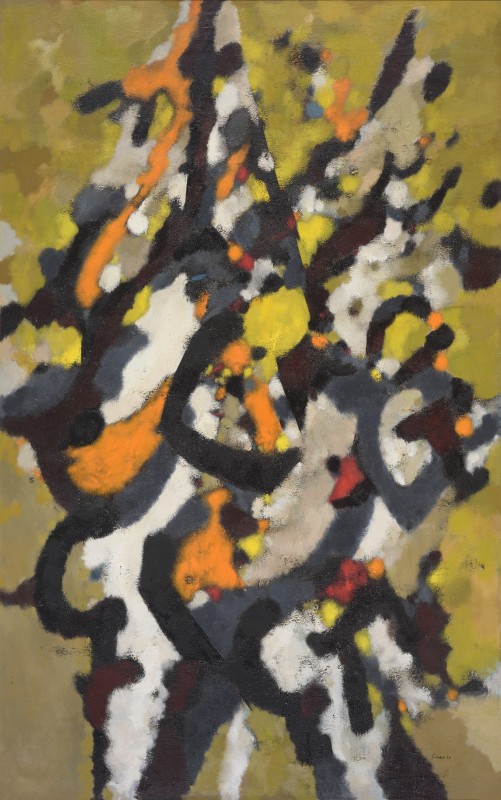 William Gear RASussex Landscape, 1959Oil on canvas204 x 127 cmSigned and dated; titled verso%3Cdiv%20class%3D%22artist%22%3E%3Cspan%20class%3D%22artist%22%3E%3Cstrong%3EWilliam%20Gear%20RA%3C/strong%3E%3C/span%3E%3C/div%3E%0D%3Cdiv%20class%3D%22title%22%3E%3Cem%3ESussex%20Landscape%3C/em%3E%2C%201959%3C/div%3E%0D%3Cdiv%20class%3D%22signed_and_dated%22%3ESigned%20and%20dated%3B%20titled%20verso%3C/div%3E%0D%3Cdiv%20class%3D%22medium%22%3EOil%20on%20canvas%3C/div%3E%0D%3Cdiv%20class%3D%22dimensions%22%3E204%20x%20127%20cm%3C/div%3E
William Gear RASussex Landscape, 1959Oil on canvas204 x 127 cmSigned and dated; titled verso%3Cdiv%20class%3D%22artist%22%3E%3Cspan%20class%3D%22artist%22%3E%3Cstrong%3EWilliam%20Gear%20RA%3C/strong%3E%3C/span%3E%3C/div%3E%0D%3Cdiv%20class%3D%22title%22%3E%3Cem%3ESussex%20Landscape%3C/em%3E%2C%201959%3C/div%3E%0D%3Cdiv%20class%3D%22signed_and_dated%22%3ESigned%20and%20dated%3B%20titled%20verso%3C/div%3E%0D%3Cdiv%20class%3D%22medium%22%3EOil%20on%20canvas%3C/div%3E%0D%3Cdiv%20class%3D%22dimensions%22%3E204%20x%20127%20cm%3C/div%3E -
 William Gear RACarnival, 1958Screenprint38 x 55 cm (sheet: 52 x 70 cm)From the edition of 25 impressionsSigned, dated, titled and numbered%3Cdiv%20class%3D%22artist%22%3E%3Cspan%20class%3D%22artist%22%3E%3Cstrong%3EWilliam%20Gear%20RA%3C/strong%3E%3C/span%3E%3C/div%3E%0D%3Cdiv%20class%3D%22title%22%3E%3Cem%3ECarnival%3C/em%3E%2C%201958%3C/div%3E%0D%3Cdiv%20class%3D%22signed_and_dated%22%3ESigned%2C%20dated%2C%20titled%20and%20numbered%3C/div%3E%0D%3Cdiv%20class%3D%22medium%22%3EScreenprint%3C/div%3E%0D%3Cdiv%20class%3D%22dimensions%22%3E38%20x%2055%20cm%20%28sheet%3A%2052%20x%2070%20cm%29%3C/div%3E%0D%3Cdiv%20class%3D%22edition_details%22%3EFrom%20the%20edition%20of%2025%20impressions%3C/div%3E
William Gear RACarnival, 1958Screenprint38 x 55 cm (sheet: 52 x 70 cm)From the edition of 25 impressionsSigned, dated, titled and numbered%3Cdiv%20class%3D%22artist%22%3E%3Cspan%20class%3D%22artist%22%3E%3Cstrong%3EWilliam%20Gear%20RA%3C/strong%3E%3C/span%3E%3C/div%3E%0D%3Cdiv%20class%3D%22title%22%3E%3Cem%3ECarnival%3C/em%3E%2C%201958%3C/div%3E%0D%3Cdiv%20class%3D%22signed_and_dated%22%3ESigned%2C%20dated%2C%20titled%20and%20numbered%3C/div%3E%0D%3Cdiv%20class%3D%22medium%22%3EScreenprint%3C/div%3E%0D%3Cdiv%20class%3D%22dimensions%22%3E38%20x%2055%20cm%20%28sheet%3A%2052%20x%2070%20cm%29%3C/div%3E%0D%3Cdiv%20class%3D%22edition_details%22%3EFrom%20the%20edition%20of%2025%20impressions%3C/div%3E -
 William Gear RAFireworks, 1958Screenprint51 x 34 cm (sheet: 62 x 50 cm)From the edition of 25 impressionsSigned, dated, titled and numbered%3Cdiv%20class%3D%22artist%22%3E%3Cspan%20class%3D%22artist%22%3E%3Cstrong%3EWilliam%20Gear%20RA%3C/strong%3E%3C/span%3E%3C/div%3E%0D%3Cdiv%20class%3D%22title%22%3E%3Cem%3EFireworks%3C/em%3E%2C%201958%3C/div%3E%0D%3Cdiv%20class%3D%22signed_and_dated%22%3ESigned%2C%20dated%2C%20titled%20and%20numbered%3C/div%3E%0D%3Cdiv%20class%3D%22medium%22%3EScreenprint%3C/div%3E%0D%3Cdiv%20class%3D%22dimensions%22%3E51%20x%2034%20cm%20%28sheet%3A%2062%20x%2050%20cm%29%3C/div%3E%0D%3Cdiv%20class%3D%22edition_details%22%3EFrom%20the%20edition%20of%2025%20impressions%3C/div%3E
William Gear RAFireworks, 1958Screenprint51 x 34 cm (sheet: 62 x 50 cm)From the edition of 25 impressionsSigned, dated, titled and numbered%3Cdiv%20class%3D%22artist%22%3E%3Cspan%20class%3D%22artist%22%3E%3Cstrong%3EWilliam%20Gear%20RA%3C/strong%3E%3C/span%3E%3C/div%3E%0D%3Cdiv%20class%3D%22title%22%3E%3Cem%3EFireworks%3C/em%3E%2C%201958%3C/div%3E%0D%3Cdiv%20class%3D%22signed_and_dated%22%3ESigned%2C%20dated%2C%20titled%20and%20numbered%3C/div%3E%0D%3Cdiv%20class%3D%22medium%22%3EScreenprint%3C/div%3E%0D%3Cdiv%20class%3D%22dimensions%22%3E51%20x%2034%20cm%20%28sheet%3A%2062%20x%2050%20cm%29%3C/div%3E%0D%3Cdiv%20class%3D%22edition_details%22%3EFrom%20the%20edition%20of%2025%20impressions%3C/div%3E -
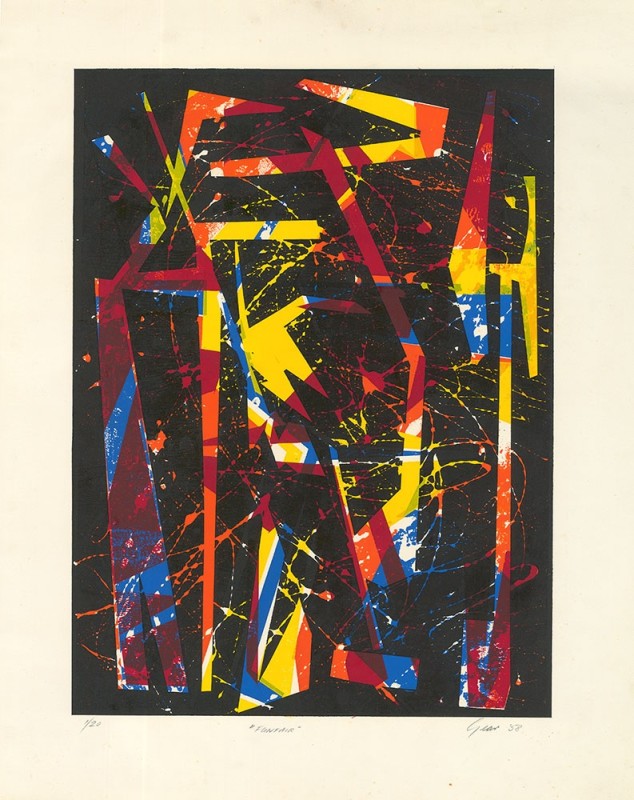 William Gear RAFun Fair, 1958Screenprint49 x 36 cm (sheet: 62 x 49 cm)From the edition of 20 impressionsSigned, dated, titled and numbered%3Cdiv%20class%3D%22artist%22%3E%3Cspan%20class%3D%22artist%22%3E%3Cstrong%3EWilliam%20Gear%20RA%3C/strong%3E%3C/span%3E%3C/div%3E%0D%3Cdiv%20class%3D%22title%22%3E%3Cem%3EFun%20Fair%3C/em%3E%2C%201958%3C/div%3E%0D%3Cdiv%20class%3D%22signed_and_dated%22%3ESigned%2C%20dated%2C%20titled%20and%20numbered%3C/div%3E%0D%3Cdiv%20class%3D%22medium%22%3EScreenprint%3C/div%3E%0D%3Cdiv%20class%3D%22dimensions%22%3E49%20x%2036%20cm%20%28sheet%3A%2062%20x%2049%20cm%29%3C/div%3E%0D%3Cdiv%20class%3D%22edition_details%22%3EFrom%20the%20edition%20of%2020%20impressions%3C/div%3E
William Gear RAFun Fair, 1958Screenprint49 x 36 cm (sheet: 62 x 49 cm)From the edition of 20 impressionsSigned, dated, titled and numbered%3Cdiv%20class%3D%22artist%22%3E%3Cspan%20class%3D%22artist%22%3E%3Cstrong%3EWilliam%20Gear%20RA%3C/strong%3E%3C/span%3E%3C/div%3E%0D%3Cdiv%20class%3D%22title%22%3E%3Cem%3EFun%20Fair%3C/em%3E%2C%201958%3C/div%3E%0D%3Cdiv%20class%3D%22signed_and_dated%22%3ESigned%2C%20dated%2C%20titled%20and%20numbered%3C/div%3E%0D%3Cdiv%20class%3D%22medium%22%3EScreenprint%3C/div%3E%0D%3Cdiv%20class%3D%22dimensions%22%3E49%20x%2036%20cm%20%28sheet%3A%2062%20x%2049%20cm%29%3C/div%3E%0D%3Cdiv%20class%3D%22edition_details%22%3EFrom%20the%20edition%20of%2020%20impressions%3C/div%3E -
 William Gear RAUntitled, 1958Gouache and ink on paper57 x 79cm%3Cdiv%20class%3D%22artist%22%3E%3Cspan%20class%3D%22artist%22%3E%3Cstrong%3EWilliam%20Gear%20RA%3C/strong%3E%3C/span%3E%3C/div%3E%0D%3Cdiv%20class%3D%22title%22%3E%3Cem%3EUntitled%3C/em%3E%2C%201958%3C/div%3E%0D%3Cdiv%20class%3D%22medium%22%3EGouache%20and%20ink%20on%20paper%3C/div%3E%0D%3Cdiv%20class%3D%22dimensions%22%3E57%20x%2079cm%3C/div%3E
William Gear RAUntitled, 1958Gouache and ink on paper57 x 79cm%3Cdiv%20class%3D%22artist%22%3E%3Cspan%20class%3D%22artist%22%3E%3Cstrong%3EWilliam%20Gear%20RA%3C/strong%3E%3C/span%3E%3C/div%3E%0D%3Cdiv%20class%3D%22title%22%3E%3Cem%3EUntitled%3C/em%3E%2C%201958%3C/div%3E%0D%3Cdiv%20class%3D%22medium%22%3EGouache%20and%20ink%20on%20paper%3C/div%3E%0D%3Cdiv%20class%3D%22dimensions%22%3E57%20x%2079cm%3C/div%3E -
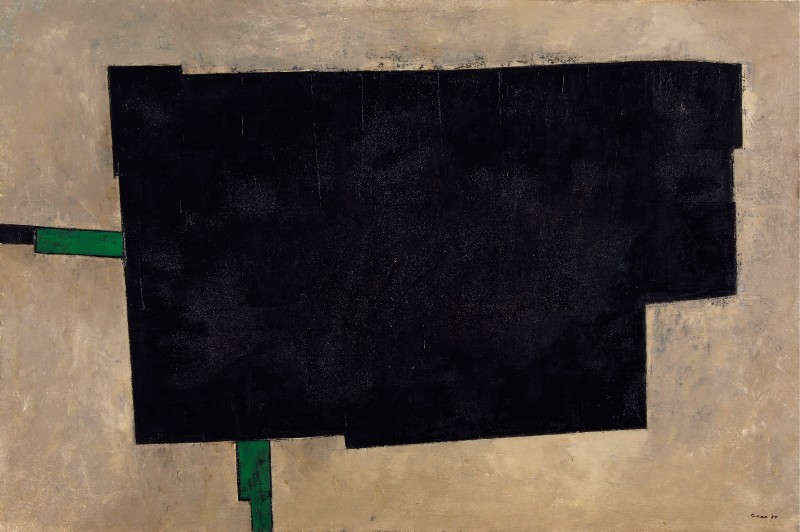 William Gear RABlack Rectangle, 1957Oil on canvas82 x 122 cmSigned and dated lower right; titled verso%3Cdiv%20class%3D%22artist%22%3E%3Cspan%20class%3D%22artist%22%3E%3Cstrong%3EWilliam%20Gear%20RA%3C/strong%3E%3C/span%3E%3C/div%3E%0D%3Cdiv%20class%3D%22title%22%3E%3Cem%3EBlack%20Rectangle%3C/em%3E%2C%201957%3C/div%3E%0D%3Cdiv%20class%3D%22signed_and_dated%22%3ESigned%20and%20dated%20lower%20right%3B%20titled%20verso%3C/div%3E%0D%3Cdiv%20class%3D%22medium%22%3EOil%20on%20canvas%3C/div%3E%0D%3Cdiv%20class%3D%22dimensions%22%3E82%20x%20122%20cm%3C/div%3E
William Gear RABlack Rectangle, 1957Oil on canvas82 x 122 cmSigned and dated lower right; titled verso%3Cdiv%20class%3D%22artist%22%3E%3Cspan%20class%3D%22artist%22%3E%3Cstrong%3EWilliam%20Gear%20RA%3C/strong%3E%3C/span%3E%3C/div%3E%0D%3Cdiv%20class%3D%22title%22%3E%3Cem%3EBlack%20Rectangle%3C/em%3E%2C%201957%3C/div%3E%0D%3Cdiv%20class%3D%22signed_and_dated%22%3ESigned%20and%20dated%20lower%20right%3B%20titled%20verso%3C/div%3E%0D%3Cdiv%20class%3D%22medium%22%3EOil%20on%20canvas%3C/div%3E%0D%3Cdiv%20class%3D%22dimensions%22%3E82%20x%20122%20cm%3C/div%3E -
 William Gear rAZoroaster No. 1, 1957Oil on canvas91 x 61 cmSigned and dated lower right; titled verso%3Cdiv%20class%3D%22artist%22%3E%3Cspan%20class%3D%22artist%22%3E%3Cstrong%3EWilliam%20Gear%20rA%3C/strong%3E%3C/span%3E%3C/div%3E%0D%3Cdiv%20class%3D%22title%22%3E%3Cem%3EZoroaster%20No.%201%3C/em%3E%2C%201957%3C/div%3E%0D%3Cdiv%20class%3D%22signed_and_dated%22%3ESigned%20and%20dated%20lower%20right%3B%20titled%20verso%3C/div%3E%0D%3Cdiv%20class%3D%22medium%22%3EOil%20on%20canvas%3C/div%3E%0D%3Cdiv%20class%3D%22dimensions%22%3E91%20x%2061%20cm%3C/div%3E
William Gear rAZoroaster No. 1, 1957Oil on canvas91 x 61 cmSigned and dated lower right; titled verso%3Cdiv%20class%3D%22artist%22%3E%3Cspan%20class%3D%22artist%22%3E%3Cstrong%3EWilliam%20Gear%20rA%3C/strong%3E%3C/span%3E%3C/div%3E%0D%3Cdiv%20class%3D%22title%22%3E%3Cem%3EZoroaster%20No.%201%3C/em%3E%2C%201957%3C/div%3E%0D%3Cdiv%20class%3D%22signed_and_dated%22%3ESigned%20and%20dated%20lower%20right%3B%20titled%20verso%3C/div%3E%0D%3Cdiv%20class%3D%22medium%22%3EOil%20on%20canvas%3C/div%3E%0D%3Cdiv%20class%3D%22dimensions%22%3E91%20x%2061%20cm%3C/div%3E -
 William Gear RAStill Life, 1955Linocut47 x 59 cm (sheet)From the edition of 15 impressionsSigned, dated and numbered%3Cdiv%20class%3D%22artist%22%3E%3Cspan%20class%3D%22artist%22%3E%3Cstrong%3EWilliam%20Gear%20RA%3C/strong%3E%3C/span%3E%3C/div%3E%0D%3Cdiv%20class%3D%22title%22%3E%3Cem%3EStill%20Life%3C/em%3E%2C%201955%3C/div%3E%0D%3Cdiv%20class%3D%22signed_and_dated%22%3ESigned%2C%20dated%20and%20numbered%3C/div%3E%0D%3Cdiv%20class%3D%22medium%22%3ELinocut%3C/div%3E%0D%3Cdiv%20class%3D%22dimensions%22%3E47%20x%2059%20cm%20%28sheet%29%3C/div%3E%0D%3Cdiv%20class%3D%22edition_details%22%3EFrom%20the%20edition%20of%2015%20impressions%3C/div%3E
William Gear RAStill Life, 1955Linocut47 x 59 cm (sheet)From the edition of 15 impressionsSigned, dated and numbered%3Cdiv%20class%3D%22artist%22%3E%3Cspan%20class%3D%22artist%22%3E%3Cstrong%3EWilliam%20Gear%20RA%3C/strong%3E%3C/span%3E%3C/div%3E%0D%3Cdiv%20class%3D%22title%22%3E%3Cem%3EStill%20Life%3C/em%3E%2C%201955%3C/div%3E%0D%3Cdiv%20class%3D%22signed_and_dated%22%3ESigned%2C%20dated%20and%20numbered%3C/div%3E%0D%3Cdiv%20class%3D%22medium%22%3ELinocut%3C/div%3E%0D%3Cdiv%20class%3D%22dimensions%22%3E47%20x%2059%20cm%20%28sheet%29%3C/div%3E%0D%3Cdiv%20class%3D%22edition_details%22%3EFrom%20the%20edition%20of%2015%20impressions%3C/div%3E -
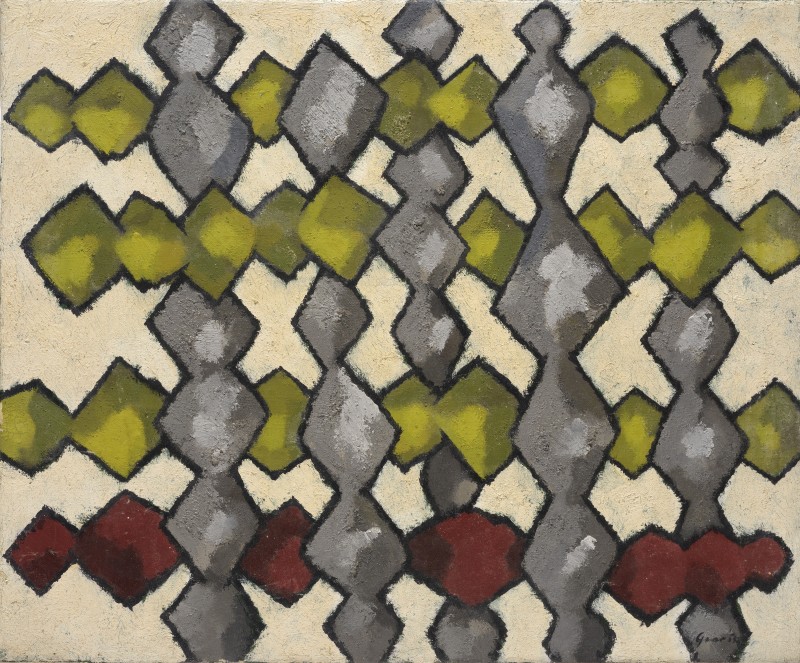 William Gear RALattice, 1953Oil on canvas54 x 65 cmSigned and dated lower right; titled verso%3Cdiv%20class%3D%22artist%22%3E%3Cspan%20class%3D%22artist%22%3E%3Cstrong%3EWilliam%20Gear%20RA%3C/strong%3E%3C/span%3E%3C/div%3E%0D%3Cdiv%20class%3D%22title%22%3E%3Cem%3ELattice%3C/em%3E%2C%201953%3C/div%3E%0D%3Cdiv%20class%3D%22signed_and_dated%22%3ESigned%20and%20dated%20lower%20right%3B%20titled%20verso%3C/div%3E%0D%3Cdiv%20class%3D%22medium%22%3EOil%20on%20canvas%3C/div%3E%0D%3Cdiv%20class%3D%22dimensions%22%3E54%20x%2065%20cm%3C/div%3E
William Gear RALattice, 1953Oil on canvas54 x 65 cmSigned and dated lower right; titled verso%3Cdiv%20class%3D%22artist%22%3E%3Cspan%20class%3D%22artist%22%3E%3Cstrong%3EWilliam%20Gear%20RA%3C/strong%3E%3C/span%3E%3C/div%3E%0D%3Cdiv%20class%3D%22title%22%3E%3Cem%3ELattice%3C/em%3E%2C%201953%3C/div%3E%0D%3Cdiv%20class%3D%22signed_and_dated%22%3ESigned%20and%20dated%20lower%20right%3B%20titled%20verso%3C/div%3E%0D%3Cdiv%20class%3D%22medium%22%3EOil%20on%20canvas%3C/div%3E%0D%3Cdiv%20class%3D%22dimensions%22%3E54%20x%2065%20cm%3C/div%3E -
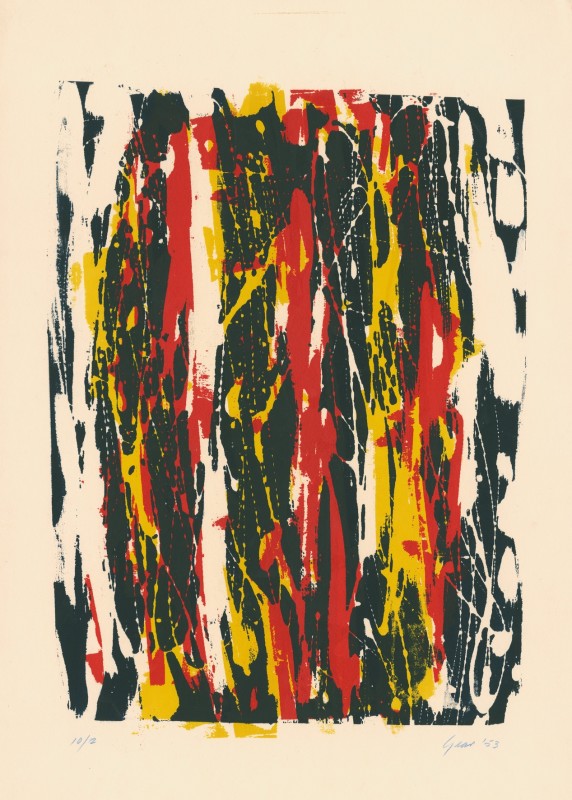 William Gear RANovember 5th, 1953Screenprint42 x 31 cm (sheet: 56 x 38 cm)
William Gear RANovember 5th, 1953Screenprint42 x 31 cm (sheet: 56 x 38 cm)
From the edition of 12 impressionsSigned, dated and numbered%3Cdiv%20class%3D%22artist%22%3E%3Cspan%20class%3D%22artist%22%3E%3Cstrong%3EWilliam%20Gear%20RA%3C/strong%3E%3C/span%3E%3C/div%3E%0D%3Cdiv%20class%3D%22title%22%3E%3Cem%3ENovember%205th%3C/em%3E%2C%201953%3C/div%3E%0D%3Cdiv%20class%3D%22signed_and_dated%22%3ESigned%2C%20dated%20and%20numbered%3C/div%3E%0D%3Cdiv%20class%3D%22medium%22%3EScreenprint%3C/div%3E%0D%3Cdiv%20class%3D%22dimensions%22%3E42%20x%2031%20cm%20%28sheet%3A%2056%20x%2038%20cm%29%3Cbr%20/%3E%0A%3C/div%3E%0D%3Cdiv%20class%3D%22edition_details%22%3EFrom%20the%20edition%20of%2012%20impressions%3C/div%3E -
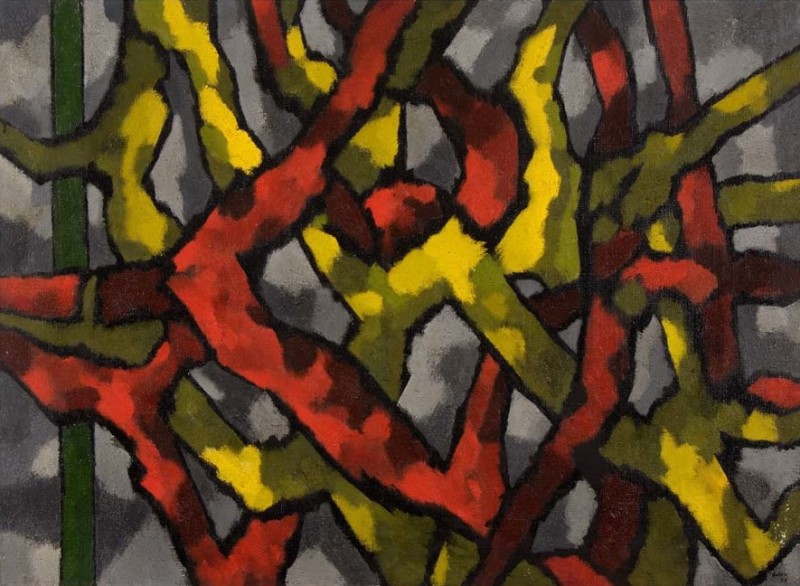 William Gear RARed and Yellow Trunks, 1953Oil on canvas73 x 100 cmSigned and dated lower right; titled verso%3Cdiv%20class%3D%22artist%22%3E%3Cspan%20class%3D%22artist%22%3E%3Cstrong%3EWilliam%20Gear%20RA%3C/strong%3E%3C/span%3E%3C/div%3E%0D%3Cdiv%20class%3D%22title%22%3E%3Cem%3ERed%20and%20Yellow%20Trunks%3C/em%3E%2C%201953%3C/div%3E%0D%3Cdiv%20class%3D%22signed_and_dated%22%3ESigned%20and%20dated%20lower%20right%3B%20titled%20verso%3C/div%3E%0D%3Cdiv%20class%3D%22medium%22%3EOil%20on%20canvas%3C/div%3E%0D%3Cdiv%20class%3D%22dimensions%22%3E73%20x%20100%20cm%3C/div%3E
William Gear RARed and Yellow Trunks, 1953Oil on canvas73 x 100 cmSigned and dated lower right; titled verso%3Cdiv%20class%3D%22artist%22%3E%3Cspan%20class%3D%22artist%22%3E%3Cstrong%3EWilliam%20Gear%20RA%3C/strong%3E%3C/span%3E%3C/div%3E%0D%3Cdiv%20class%3D%22title%22%3E%3Cem%3ERed%20and%20Yellow%20Trunks%3C/em%3E%2C%201953%3C/div%3E%0D%3Cdiv%20class%3D%22signed_and_dated%22%3ESigned%20and%20dated%20lower%20right%3B%20titled%20verso%3C/div%3E%0D%3Cdiv%20class%3D%22medium%22%3EOil%20on%20canvas%3C/div%3E%0D%3Cdiv%20class%3D%22dimensions%22%3E73%20x%20100%20cm%3C/div%3E -
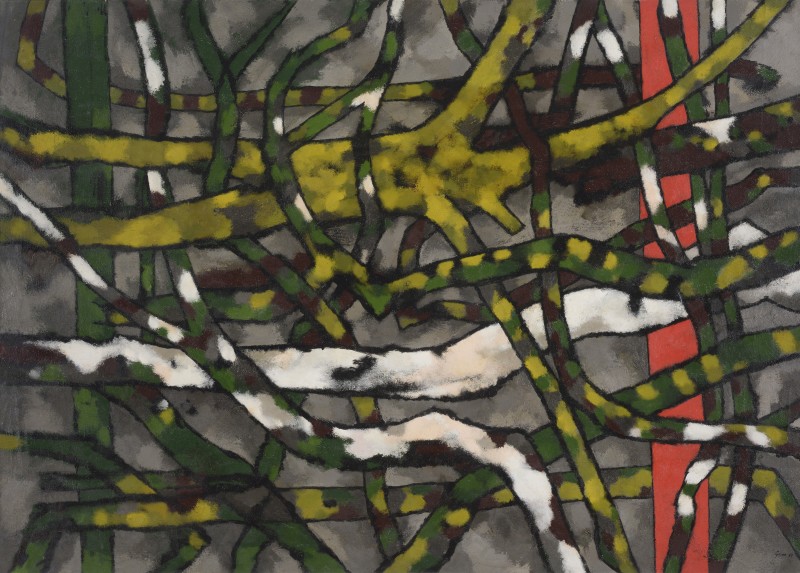 William Gear RATangled Trunks, 1953Oil on canvas127 x 183 cmSigned and dated lower right; titled verso%3Cdiv%20class%3D%22artist%22%3E%3Cspan%20class%3D%22artist%22%3E%3Cstrong%3EWilliam%20Gear%20RA%3C/strong%3E%3C/span%3E%3C/div%3E%0D%3Cdiv%20class%3D%22title%22%3E%3Cem%3ETangled%20Trunks%3C/em%3E%2C%201953%3C/div%3E%0D%3Cdiv%20class%3D%22signed_and_dated%22%3ESigned%20and%20dated%20lower%20right%3B%20titled%20verso%3C/div%3E%0D%3Cdiv%20class%3D%22medium%22%3EOil%20on%20canvas%3C/div%3E%0D%3Cdiv%20class%3D%22dimensions%22%3E127%20x%20183%20cm%3C/div%3E
William Gear RATangled Trunks, 1953Oil on canvas127 x 183 cmSigned and dated lower right; titled verso%3Cdiv%20class%3D%22artist%22%3E%3Cspan%20class%3D%22artist%22%3E%3Cstrong%3EWilliam%20Gear%20RA%3C/strong%3E%3C/span%3E%3C/div%3E%0D%3Cdiv%20class%3D%22title%22%3E%3Cem%3ETangled%20Trunks%3C/em%3E%2C%201953%3C/div%3E%0D%3Cdiv%20class%3D%22signed_and_dated%22%3ESigned%20and%20dated%20lower%20right%3B%20titled%20verso%3C/div%3E%0D%3Cdiv%20class%3D%22medium%22%3EOil%20on%20canvas%3C/div%3E%0D%3Cdiv%20class%3D%22dimensions%22%3E127%20x%20183%20cm%3C/div%3E -
 William Gear RATrunks, Nocturne, 1953Oil on canvas152.5 x 91.5 cmSigned and dated lower right; titled verso%3Cdiv%20class%3D%22artist%22%3E%3Cspan%20class%3D%22artist%22%3E%3Cstrong%3EWilliam%20Gear%20RA%3C/strong%3E%3C/span%3E%3C/div%3E%0D%3Cdiv%20class%3D%22title%22%3E%3Cem%3ETrunks%2C%20Nocturne%3C/em%3E%2C%201953%3C/div%3E%0D%3Cdiv%20class%3D%22signed_and_dated%22%3ESigned%20and%20dated%20lower%20right%3B%20titled%20verso%3C/div%3E%0D%3Cdiv%20class%3D%22medium%22%3EOil%20on%20canvas%3C/div%3E%0D%3Cdiv%20class%3D%22dimensions%22%3E152.5%20x%2091.5%20cm%3C/div%3E
William Gear RATrunks, Nocturne, 1953Oil on canvas152.5 x 91.5 cmSigned and dated lower right; titled verso%3Cdiv%20class%3D%22artist%22%3E%3Cspan%20class%3D%22artist%22%3E%3Cstrong%3EWilliam%20Gear%20RA%3C/strong%3E%3C/span%3E%3C/div%3E%0D%3Cdiv%20class%3D%22title%22%3E%3Cem%3ETrunks%2C%20Nocturne%3C/em%3E%2C%201953%3C/div%3E%0D%3Cdiv%20class%3D%22signed_and_dated%22%3ESigned%20and%20dated%20lower%20right%3B%20titled%20verso%3C/div%3E%0D%3Cdiv%20class%3D%22medium%22%3EOil%20on%20canvas%3C/div%3E%0D%3Cdiv%20class%3D%22dimensions%22%3E152.5%20x%2091.5%20cm%3C/div%3E -
 William Gear RAUntitled (November 11th), 1953Screenprint41 x 30 cm (sheet: 56 x 38 cm)From the edition of 15 impressionsSigned, dated and numbered%3Cdiv%20class%3D%22artist%22%3E%3Cspan%20class%3D%22artist%22%3E%3Cstrong%3EWilliam%20Gear%20RA%3C/strong%3E%3C/span%3E%3C/div%3E%0D%3Cdiv%20class%3D%22title%22%3E%3Cem%3EUntitled%20%28November%2011th%29%3C/em%3E%2C%201953%3C/div%3E%0D%3Cdiv%20class%3D%22signed_and_dated%22%3ESigned%2C%20dated%20and%20numbered%3C/div%3E%0D%3Cdiv%20class%3D%22medium%22%3EScreenprint%3C/div%3E%0D%3Cdiv%20class%3D%22dimensions%22%3E41%20x%2030%20cm%20%28sheet%3A%2056%20x%2038%20cm%29%3C/div%3E%0D%3Cdiv%20class%3D%22edition_details%22%3EFrom%20the%20edition%20of%2015%20impressions%3C/div%3E
William Gear RAUntitled (November 11th), 1953Screenprint41 x 30 cm (sheet: 56 x 38 cm)From the edition of 15 impressionsSigned, dated and numbered%3Cdiv%20class%3D%22artist%22%3E%3Cspan%20class%3D%22artist%22%3E%3Cstrong%3EWilliam%20Gear%20RA%3C/strong%3E%3C/span%3E%3C/div%3E%0D%3Cdiv%20class%3D%22title%22%3E%3Cem%3EUntitled%20%28November%2011th%29%3C/em%3E%2C%201953%3C/div%3E%0D%3Cdiv%20class%3D%22signed_and_dated%22%3ESigned%2C%20dated%20and%20numbered%3C/div%3E%0D%3Cdiv%20class%3D%22medium%22%3EScreenprint%3C/div%3E%0D%3Cdiv%20class%3D%22dimensions%22%3E41%20x%2030%20cm%20%28sheet%3A%2056%20x%2038%20cm%29%3C/div%3E%0D%3Cdiv%20class%3D%22edition_details%22%3EFrom%20the%20edition%20of%2015%20impressions%3C/div%3E -
 William Gear RAHedgerow Trunks, 1952Screenprint44 x 26 cm (sheet: 56 x 38 cm)From the edition of 20 impressionsSigned, dated and numbered%3Cdiv%20class%3D%22artist%22%3E%3Cspan%20class%3D%22artist%22%3E%3Cstrong%3EWilliam%20Gear%20RA%3C/strong%3E%3C/span%3E%3C/div%3E%0D%3Cdiv%20class%3D%22title%22%3E%3Cem%3EHedgerow%20Trunks%3C/em%3E%2C%201952%3C/div%3E%0D%3Cdiv%20class%3D%22signed_and_dated%22%3ESigned%2C%20dated%20and%20numbered%3C/div%3E%0D%3Cdiv%20class%3D%22medium%22%3EScreenprint%3C/div%3E%0D%3Cdiv%20class%3D%22dimensions%22%3E44%20x%2026%20cm%20%28sheet%3A%2056%20x%2038%20cm%29%3C/div%3E%0D%3Cdiv%20class%3D%22edition_details%22%3EFrom%20the%20edition%20of%2020%20impressions%3C/div%3E
William Gear RAHedgerow Trunks, 1952Screenprint44 x 26 cm (sheet: 56 x 38 cm)From the edition of 20 impressionsSigned, dated and numbered%3Cdiv%20class%3D%22artist%22%3E%3Cspan%20class%3D%22artist%22%3E%3Cstrong%3EWilliam%20Gear%20RA%3C/strong%3E%3C/span%3E%3C/div%3E%0D%3Cdiv%20class%3D%22title%22%3E%3Cem%3EHedgerow%20Trunks%3C/em%3E%2C%201952%3C/div%3E%0D%3Cdiv%20class%3D%22signed_and_dated%22%3ESigned%2C%20dated%20and%20numbered%3C/div%3E%0D%3Cdiv%20class%3D%22medium%22%3EScreenprint%3C/div%3E%0D%3Cdiv%20class%3D%22dimensions%22%3E44%20x%2026%20cm%20%28sheet%3A%2056%20x%2038%20cm%29%3C/div%3E%0D%3Cdiv%20class%3D%22edition_details%22%3EFrom%20the%20edition%20of%2020%20impressions%3C/div%3E -
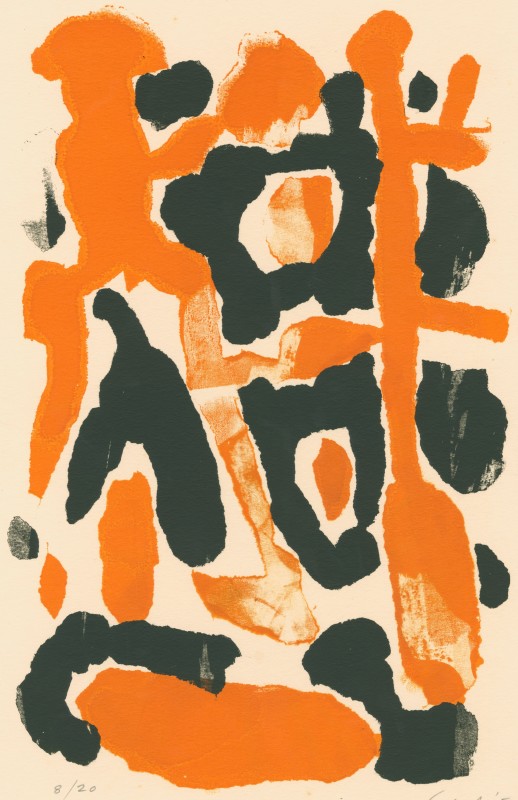 William Gear RAOrange / Black, 1952Screenprint40 x 26 cm (sheet: 56 x 38 cm)From the edition of 20 impressionsSigned, dated and numbered%3Cdiv%20class%3D%22artist%22%3E%3Cspan%20class%3D%22artist%22%3E%3Cstrong%3EWilliam%20Gear%20RA%3C/strong%3E%3C/span%3E%3C/div%3E%0D%3Cdiv%20class%3D%22title%22%3E%3Cem%3EOrange%20/%20Black%3C/em%3E%2C%201952%3C/div%3E%0D%3Cdiv%20class%3D%22signed_and_dated%22%3ESigned%2C%20dated%20and%20numbered%3C/div%3E%0D%3Cdiv%20class%3D%22medium%22%3EScreenprint%3C/div%3E%0D%3Cdiv%20class%3D%22dimensions%22%3E40%20x%2026%20cm%20%28sheet%3A%2056%20x%2038%20cm%29%3C/div%3E%0D%3Cdiv%20class%3D%22edition_details%22%3EFrom%20the%20edition%20of%2020%20impressions%3C/div%3E
William Gear RAOrange / Black, 1952Screenprint40 x 26 cm (sheet: 56 x 38 cm)From the edition of 20 impressionsSigned, dated and numbered%3Cdiv%20class%3D%22artist%22%3E%3Cspan%20class%3D%22artist%22%3E%3Cstrong%3EWilliam%20Gear%20RA%3C/strong%3E%3C/span%3E%3C/div%3E%0D%3Cdiv%20class%3D%22title%22%3E%3Cem%3EOrange%20/%20Black%3C/em%3E%2C%201952%3C/div%3E%0D%3Cdiv%20class%3D%22signed_and_dated%22%3ESigned%2C%20dated%20and%20numbered%3C/div%3E%0D%3Cdiv%20class%3D%22medium%22%3EScreenprint%3C/div%3E%0D%3Cdiv%20class%3D%22dimensions%22%3E40%20x%2026%20cm%20%28sheet%3A%2056%20x%2038%20cm%29%3C/div%3E%0D%3Cdiv%20class%3D%22edition_details%22%3EFrom%20the%20edition%20of%2020%20impressions%3C/div%3E -
 William Gear RATrellis, 1952Lithograph28 x 40 cm (sheet: 38 x 56 cm)From the edition of 25 impressionsSigned, dated and numbered%3Cdiv%20class%3D%22artist%22%3E%3Cspan%20class%3D%22artist%22%3E%3Cstrong%3EWilliam%20Gear%20RA%3C/strong%3E%3C/span%3E%3C/div%3E%0D%3Cdiv%20class%3D%22title%22%3E%3Cem%3ETrellis%3C/em%3E%2C%201952%3C/div%3E%0D%3Cdiv%20class%3D%22signed_and_dated%22%3ESigned%2C%20dated%20and%20numbered%20%3C/div%3E%0D%3Cdiv%20class%3D%22medium%22%3ELithograph%3C/div%3E%0D%3Cdiv%20class%3D%22dimensions%22%3E28%20x%2040%20cm%20%28sheet%3A%2038%20x%2056%20cm%29%3C/div%3E%0D%3Cdiv%20class%3D%22edition_details%22%3EFrom%20the%20edition%20of%2025%20impressions%3C/div%3E
William Gear RATrellis, 1952Lithograph28 x 40 cm (sheet: 38 x 56 cm)From the edition of 25 impressionsSigned, dated and numbered%3Cdiv%20class%3D%22artist%22%3E%3Cspan%20class%3D%22artist%22%3E%3Cstrong%3EWilliam%20Gear%20RA%3C/strong%3E%3C/span%3E%3C/div%3E%0D%3Cdiv%20class%3D%22title%22%3E%3Cem%3ETrellis%3C/em%3E%2C%201952%3C/div%3E%0D%3Cdiv%20class%3D%22signed_and_dated%22%3ESigned%2C%20dated%20and%20numbered%20%3C/div%3E%0D%3Cdiv%20class%3D%22medium%22%3ELithograph%3C/div%3E%0D%3Cdiv%20class%3D%22dimensions%22%3E28%20x%2040%20cm%20%28sheet%3A%2038%20x%2056%20cm%29%3C/div%3E%0D%3Cdiv%20class%3D%22edition_details%22%3EFrom%20the%20edition%20of%2025%20impressions%3C/div%3E -
 William Gear RATrellis, 1952Screenprint27 x 43 cm (sheet: 38 x 56 cm)From the edition of 25 impressionsSigned, dated and numbered%3Cdiv%20class%3D%22artist%22%3E%3Cspan%20class%3D%22artist%22%3E%3Cstrong%3EWilliam%20Gear%20RA%3C/strong%3E%3C/span%3E%3C/div%3E%0D%3Cdiv%20class%3D%22title%22%3E%3Cem%3ETrellis%3C/em%3E%2C%201952%3C/div%3E%0D%3Cdiv%20class%3D%22signed_and_dated%22%3ESigned%2C%20dated%20and%20numbered%3C/div%3E%0D%3Cdiv%20class%3D%22medium%22%3EScreenprint%3C/div%3E%0D%3Cdiv%20class%3D%22dimensions%22%3E27%20x%2043%20cm%20%28sheet%3A%2038%20x%2056%20cm%29%20%3C/div%3E%0D%3Cdiv%20class%3D%22edition_details%22%3EFrom%20the%20edition%20of%2025%20impressions%3C/div%3E
William Gear RATrellis, 1952Screenprint27 x 43 cm (sheet: 38 x 56 cm)From the edition of 25 impressionsSigned, dated and numbered%3Cdiv%20class%3D%22artist%22%3E%3Cspan%20class%3D%22artist%22%3E%3Cstrong%3EWilliam%20Gear%20RA%3C/strong%3E%3C/span%3E%3C/div%3E%0D%3Cdiv%20class%3D%22title%22%3E%3Cem%3ETrellis%3C/em%3E%2C%201952%3C/div%3E%0D%3Cdiv%20class%3D%22signed_and_dated%22%3ESigned%2C%20dated%20and%20numbered%3C/div%3E%0D%3Cdiv%20class%3D%22medium%22%3EScreenprint%3C/div%3E%0D%3Cdiv%20class%3D%22dimensions%22%3E27%20x%2043%20cm%20%28sheet%3A%2038%20x%2056%20cm%29%20%3C/div%3E%0D%3Cdiv%20class%3D%22edition_details%22%3EFrom%20the%20edition%20of%2025%20impressions%3C/div%3E -
 William Gear RATrunks and Stakes, 1952Oil on canvas72 x 102 cmSigned and dated lower centre; signed, dated and titled verso%3Cdiv%20class%3D%22artist%22%3E%3Cspan%20class%3D%22artist%22%3E%3Cstrong%3EWilliam%20Gear%20RA%3C/strong%3E%3C/span%3E%3C/div%3E%0D%3Cdiv%20class%3D%22title%22%3E%3Cem%3ETrunks%20and%20Stakes%3C/em%3E%2C%201952%3C/div%3E%0D%3Cdiv%20class%3D%22signed_and_dated%22%3ESigned%20and%20dated%20lower%20centre%3B%20signed%2C%20dated%20and%20titled%20verso%3C/div%3E%0D%3Cdiv%20class%3D%22medium%22%3EOil%20on%20canvas%3C/div%3E%0D%3Cdiv%20class%3D%22dimensions%22%3E72%20x%20102%20cm%3C/div%3E
William Gear RATrunks and Stakes, 1952Oil on canvas72 x 102 cmSigned and dated lower centre; signed, dated and titled verso%3Cdiv%20class%3D%22artist%22%3E%3Cspan%20class%3D%22artist%22%3E%3Cstrong%3EWilliam%20Gear%20RA%3C/strong%3E%3C/span%3E%3C/div%3E%0D%3Cdiv%20class%3D%22title%22%3E%3Cem%3ETrunks%20and%20Stakes%3C/em%3E%2C%201952%3C/div%3E%0D%3Cdiv%20class%3D%22signed_and_dated%22%3ESigned%20and%20dated%20lower%20centre%3B%20signed%2C%20dated%20and%20titled%20verso%3C/div%3E%0D%3Cdiv%20class%3D%22medium%22%3EOil%20on%20canvas%3C/div%3E%0D%3Cdiv%20class%3D%22dimensions%22%3E72%20x%20102%20cm%3C/div%3E -
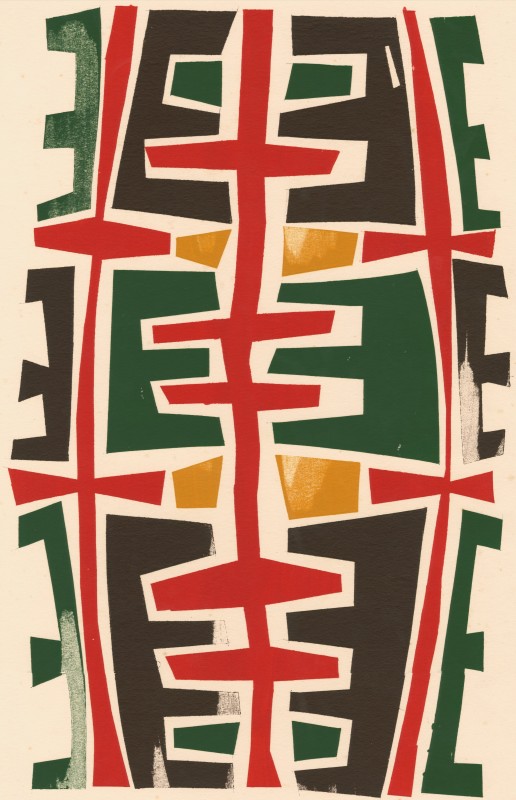 William Gear RAVertical Structure, 1952Screenprint43 x 27 cm (sheet: 56 x 38 cm)From the edition of 25 impressionsSigned, dated and numbered%3Cdiv%20class%3D%22artist%22%3E%3Cspan%20class%3D%22artist%22%3E%3Cstrong%3EWilliam%20Gear%20RA%3C/strong%3E%3C/span%3E%3C/div%3E%0D%3Cdiv%20class%3D%22title%22%3E%3Cem%3EVertical%20Structure%3C/em%3E%2C%201952%3C/div%3E%0D%3Cdiv%20class%3D%22signed_and_dated%22%3ESigned%2C%20dated%20and%20numbered%20%3C/div%3E%0D%3Cdiv%20class%3D%22medium%22%3EScreenprint%3C/div%3E%0D%3Cdiv%20class%3D%22dimensions%22%3E43%20x%2027%20cm%20%28sheet%3A%20%2056%20x%2038%20cm%29%3C/div%3E%0D%3Cdiv%20class%3D%22edition_details%22%3EFrom%20the%20edition%20of%2025%20impressions%3C/div%3E
William Gear RAVertical Structure, 1952Screenprint43 x 27 cm (sheet: 56 x 38 cm)From the edition of 25 impressionsSigned, dated and numbered%3Cdiv%20class%3D%22artist%22%3E%3Cspan%20class%3D%22artist%22%3E%3Cstrong%3EWilliam%20Gear%20RA%3C/strong%3E%3C/span%3E%3C/div%3E%0D%3Cdiv%20class%3D%22title%22%3E%3Cem%3EVertical%20Structure%3C/em%3E%2C%201952%3C/div%3E%0D%3Cdiv%20class%3D%22signed_and_dated%22%3ESigned%2C%20dated%20and%20numbered%20%3C/div%3E%0D%3Cdiv%20class%3D%22medium%22%3EScreenprint%3C/div%3E%0D%3Cdiv%20class%3D%22dimensions%22%3E43%20x%2027%20cm%20%28sheet%3A%20%2056%20x%2038%20cm%29%3C/div%3E%0D%3Cdiv%20class%3D%22edition_details%22%3EFrom%20the%20edition%20of%2025%20impressions%3C/div%3E -
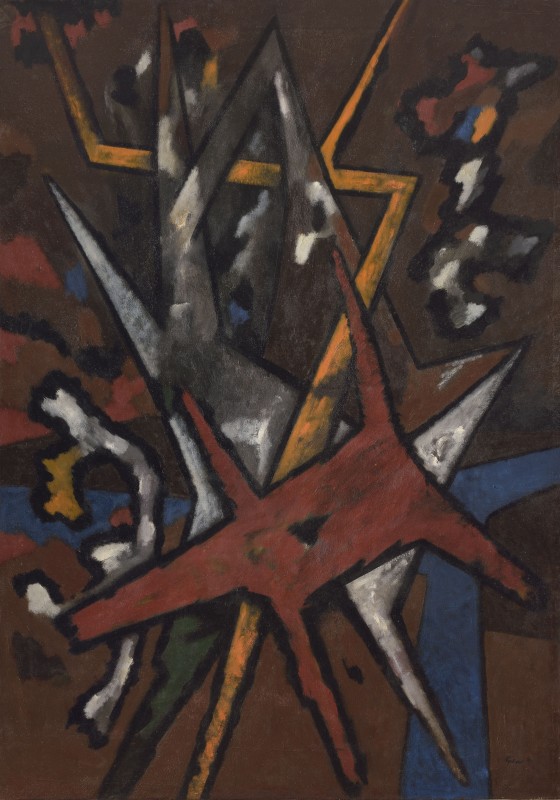 William Gear RAInterior with Sculpture, 1951Oil on canvas178 x 127 cmSigned, dated and titled verso%3Cdiv%20class%3D%22artist%22%3E%3Cspan%20class%3D%22artist%22%3E%3Cstrong%3EWilliam%20Gear%20RA%3C/strong%3E%3C/span%3E%3C/div%3E%0D%3Cdiv%20class%3D%22title%22%3E%3Cem%3EInterior%20with%20Sculpture%3C/em%3E%2C%201951%3C/div%3E%0D%3Cdiv%20class%3D%22signed_and_dated%22%3ESigned%2C%20dated%20and%20titled%20verso%3C/div%3E%0D%3Cdiv%20class%3D%22medium%22%3EOil%20on%20canvas%3C/div%3E%0D%3Cdiv%20class%3D%22dimensions%22%3E178%20x%20127%20cm%3C/div%3E
William Gear RAInterior with Sculpture, 1951Oil on canvas178 x 127 cmSigned, dated and titled verso%3Cdiv%20class%3D%22artist%22%3E%3Cspan%20class%3D%22artist%22%3E%3Cstrong%3EWilliam%20Gear%20RA%3C/strong%3E%3C/span%3E%3C/div%3E%0D%3Cdiv%20class%3D%22title%22%3E%3Cem%3EInterior%20with%20Sculpture%3C/em%3E%2C%201951%3C/div%3E%0D%3Cdiv%20class%3D%22signed_and_dated%22%3ESigned%2C%20dated%20and%20titled%20verso%3C/div%3E%0D%3Cdiv%20class%3D%22medium%22%3EOil%20on%20canvas%3C/div%3E%0D%3Cdiv%20class%3D%22dimensions%22%3E178%20x%20127%20cm%3C/div%3E -
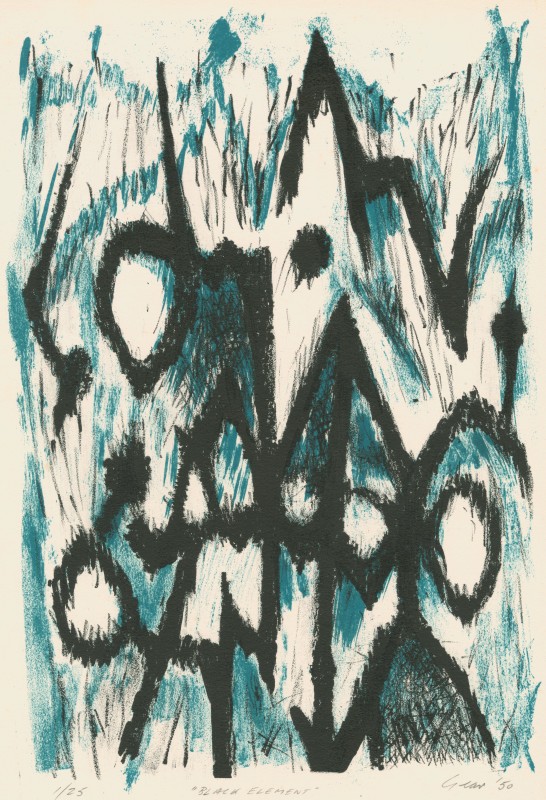 William Gear RABlack Element, 1950Lithograph40 x 27 cm (sheet: 50 x 33 cm)
William Gear RABlack Element, 1950Lithograph40 x 27 cm (sheet: 50 x 33 cm)
From the edition of 25 impressionsSigned, dated and numbered%3Cdiv%20class%3D%22artist%22%3E%3Cspan%20class%3D%22artist%22%3E%3Cstrong%3EWilliam%20Gear%20RA%3C/strong%3E%3C/span%3E%3C/div%3E%0D%3Cdiv%20class%3D%22title%22%3E%3Cem%3EBlack%20Element%3C/em%3E%2C%201950%3C/div%3E%0D%3Cdiv%20class%3D%22signed_and_dated%22%3ESigned%2C%20dated%20and%20numbered%3C/div%3E%0D%3Cdiv%20class%3D%22medium%22%3ELithograph%3C/div%3E%0D%3Cdiv%20class%3D%22dimensions%22%3E40%20x%2027%20cm%20%28sheet%3A%2050%20x%2033%20cm%29%3Cbr%20/%3E%0A%3C/div%3E%0D%3Cdiv%20class%3D%22edition_details%22%3EFrom%20the%20edition%20of%2025%20impressions%3C/div%3E -
 William Gear RABlack Tree, 1950Lithograph50 x 37 cm (sheet: 65 x 50 cm)From the edition of 15 impressionsSigned, dated and numbered%3Cdiv%20class%3D%22artist%22%3E%3Cspan%20class%3D%22artist%22%3E%3Cstrong%3EWilliam%20Gear%20RA%3C/strong%3E%3C/span%3E%3C/div%3E%0D%3Cdiv%20class%3D%22title%22%3E%3Cem%3EBlack%20Tree%3C/em%3E%2C%201950%3C/div%3E%0D%3Cdiv%20class%3D%22signed_and_dated%22%3ESigned%2C%20dated%20and%20numbered%3C/div%3E%0D%3Cdiv%20class%3D%22medium%22%3ELithograph%3C/div%3E%0D%3Cdiv%20class%3D%22dimensions%22%3E50%20x%2037%20cm%20%28sheet%3A%2065%20x%2050%20cm%29%3C/div%3E%0D%3Cdiv%20class%3D%22edition_details%22%3EFrom%20the%20edition%20of%2015%20impressions%3C/div%3E
William Gear RABlack Tree, 1950Lithograph50 x 37 cm (sheet: 65 x 50 cm)From the edition of 15 impressionsSigned, dated and numbered%3Cdiv%20class%3D%22artist%22%3E%3Cspan%20class%3D%22artist%22%3E%3Cstrong%3EWilliam%20Gear%20RA%3C/strong%3E%3C/span%3E%3C/div%3E%0D%3Cdiv%20class%3D%22title%22%3E%3Cem%3EBlack%20Tree%3C/em%3E%2C%201950%3C/div%3E%0D%3Cdiv%20class%3D%22signed_and_dated%22%3ESigned%2C%20dated%20and%20numbered%3C/div%3E%0D%3Cdiv%20class%3D%22medium%22%3ELithograph%3C/div%3E%0D%3Cdiv%20class%3D%22dimensions%22%3E50%20x%2037%20cm%20%28sheet%3A%2065%20x%2050%20cm%29%3C/div%3E%0D%3Cdiv%20class%3D%22edition_details%22%3EFrom%20the%20edition%20of%2015%20impressions%3C/div%3E -
 William Gear RALe Port Doelan, 1950Oil on canvas70.5 x 89.5 cmSigned and dated lower left; signed, dated and titled verso%3Cdiv%20class%3D%22artist%22%3E%3Cspan%20class%3D%22artist%22%3E%3Cstrong%3EWilliam%20Gear%20RA%3C/strong%3E%3C/span%3E%3C/div%3E%0D%3Cdiv%20class%3D%22title%22%3E%3Cem%3ELe%20Port%20Doelan%3C/em%3E%2C%201950%3C/div%3E%0D%3Cdiv%20class%3D%22signed_and_dated%22%3ESigned%20and%20dated%20lower%20left%3B%20signed%2C%20dated%20and%20titled%20verso%3C/div%3E%0D%3Cdiv%20class%3D%22medium%22%3EOil%20on%20canvas%3C/div%3E%0D%3Cdiv%20class%3D%22dimensions%22%3E70.5%20x%2089.5%20cm%3C/div%3E
William Gear RALe Port Doelan, 1950Oil on canvas70.5 x 89.5 cmSigned and dated lower left; signed, dated and titled verso%3Cdiv%20class%3D%22artist%22%3E%3Cspan%20class%3D%22artist%22%3E%3Cstrong%3EWilliam%20Gear%20RA%3C/strong%3E%3C/span%3E%3C/div%3E%0D%3Cdiv%20class%3D%22title%22%3E%3Cem%3ELe%20Port%20Doelan%3C/em%3E%2C%201950%3C/div%3E%0D%3Cdiv%20class%3D%22signed_and_dated%22%3ESigned%20and%20dated%20lower%20left%3B%20signed%2C%20dated%20and%20titled%20verso%3C/div%3E%0D%3Cdiv%20class%3D%22medium%22%3EOil%20on%20canvas%3C/div%3E%0D%3Cdiv%20class%3D%22dimensions%22%3E70.5%20x%2089.5%20cm%3C/div%3E -
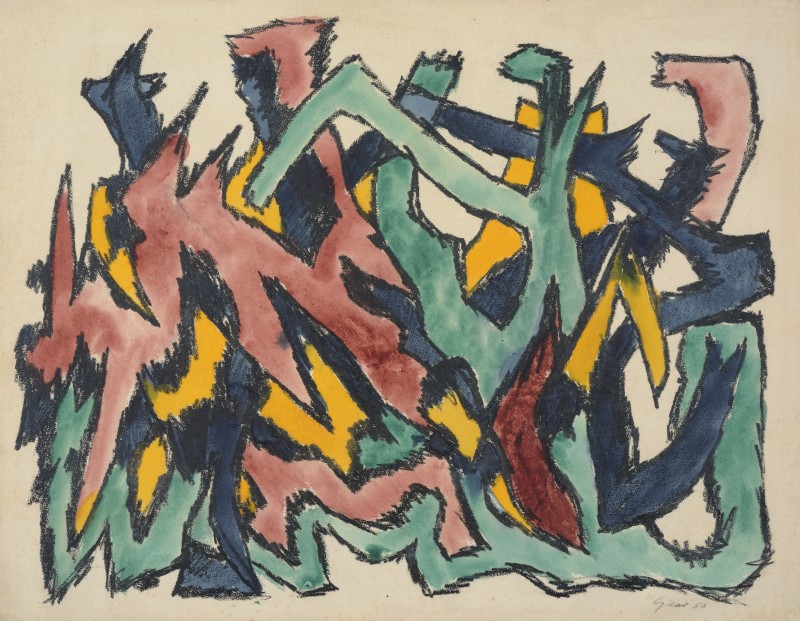 William Gear RAMarine Study, 1950Gouache and charcoal on paper50 x 64 cmSigned and dated lower right; titled verso%3Cdiv%20class%3D%22artist%22%3E%3Cspan%20class%3D%22artist%22%3E%3Cstrong%3EWilliam%20Gear%20RA%3C/strong%3E%3C/span%3E%3C/div%3E%0D%3Cdiv%20class%3D%22title%22%3E%3Cem%3EMarine%20Study%3C/em%3E%2C%201950%3C/div%3E%0D%3Cdiv%20class%3D%22signed_and_dated%22%3ESigned%20and%20dated%20lower%20right%3B%20titled%20verso%3C/div%3E%0D%3Cdiv%20class%3D%22medium%22%3EGouache%20and%20charcoal%20on%20paper%3C/div%3E%0D%3Cdiv%20class%3D%22dimensions%22%3E50%20x%2064%20cm%3C/div%3E
William Gear RAMarine Study, 1950Gouache and charcoal on paper50 x 64 cmSigned and dated lower right; titled verso%3Cdiv%20class%3D%22artist%22%3E%3Cspan%20class%3D%22artist%22%3E%3Cstrong%3EWilliam%20Gear%20RA%3C/strong%3E%3C/span%3E%3C/div%3E%0D%3Cdiv%20class%3D%22title%22%3E%3Cem%3EMarine%20Study%3C/em%3E%2C%201950%3C/div%3E%0D%3Cdiv%20class%3D%22signed_and_dated%22%3ESigned%20and%20dated%20lower%20right%3B%20titled%20verso%3C/div%3E%0D%3Cdiv%20class%3D%22medium%22%3EGouache%20and%20charcoal%20on%20paper%3C/div%3E%0D%3Cdiv%20class%3D%22dimensions%22%3E50%20x%2064%20cm%3C/div%3E -
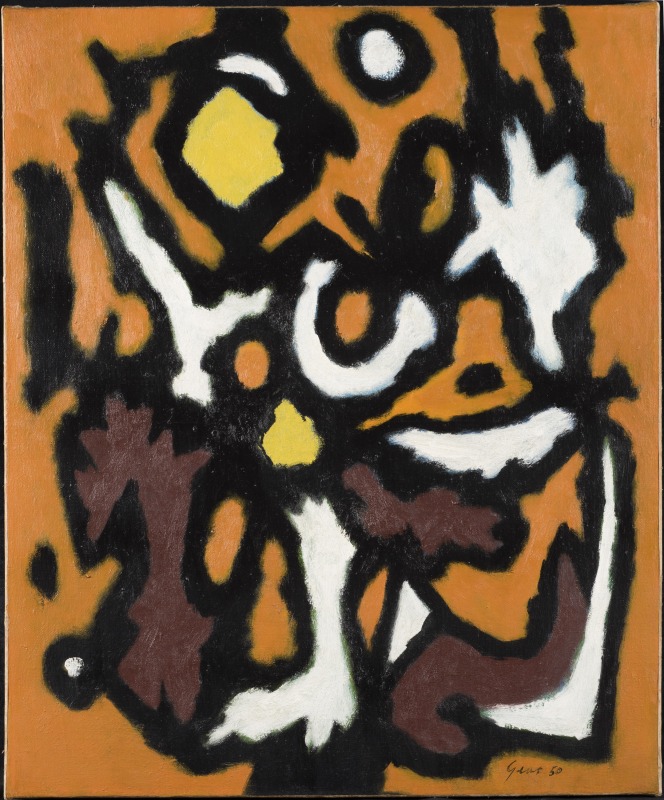 William Gear RAPeinture, 1950Oil on canvas65 x 54 cm%3Cdiv%20class%3D%22artist%22%3E%3Cspan%20class%3D%22artist%22%3E%3Cstrong%3EWilliam%20Gear%20RA%3C/strong%3E%3C/span%3E%3C/div%3E%0D%3Cdiv%20class%3D%22title%22%3E%3Cem%3EPeinture%3C/em%3E%2C%201950%3C/div%3E%0D%3Cdiv%20class%3D%22medium%22%3EOil%20on%20canvas%3C/div%3E%0D%3Cdiv%20class%3D%22dimensions%22%3E65%20x%2054%20cm%3C/div%3E
William Gear RAPeinture, 1950Oil on canvas65 x 54 cm%3Cdiv%20class%3D%22artist%22%3E%3Cspan%20class%3D%22artist%22%3E%3Cstrong%3EWilliam%20Gear%20RA%3C/strong%3E%3C/span%3E%3C/div%3E%0D%3Cdiv%20class%3D%22title%22%3E%3Cem%3EPeinture%3C/em%3E%2C%201950%3C/div%3E%0D%3Cdiv%20class%3D%22medium%22%3EOil%20on%20canvas%3C/div%3E%0D%3Cdiv%20class%3D%22dimensions%22%3E65%20x%2054%20cm%3C/div%3E -
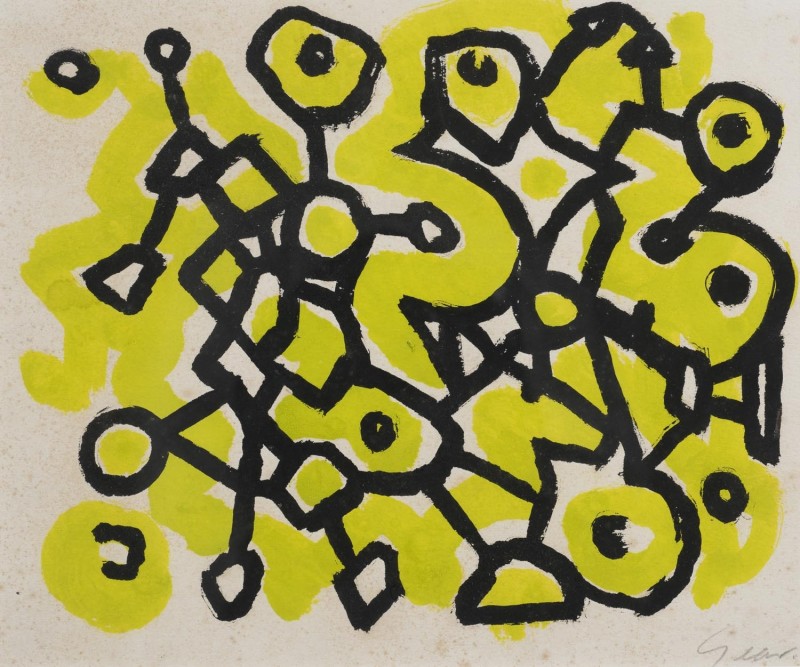 William Gear RAUntitled, 1950Ink on paper24 x 31 cmSigned lower right; dated verso%3Cdiv%20class%3D%22artist%22%3E%3Cspan%20class%3D%22artist%22%3E%3Cstrong%3EWilliam%20Gear%20RA%3C/strong%3E%3C/span%3E%3C/div%3E%0D%3Cdiv%20class%3D%22title%22%3E%3Cem%3EUntitled%3C/em%3E%2C%201950%3C/div%3E%0D%3Cdiv%20class%3D%22signed_and_dated%22%3ESigned%20lower%20right%3B%20dated%20verso%3C/div%3E%0D%3Cdiv%20class%3D%22medium%22%3EInk%20on%20paper%3C/div%3E%0D%3Cdiv%20class%3D%22dimensions%22%3E24%20x%2031%20cm%3C/div%3E
William Gear RAUntitled, 1950Ink on paper24 x 31 cmSigned lower right; dated verso%3Cdiv%20class%3D%22artist%22%3E%3Cspan%20class%3D%22artist%22%3E%3Cstrong%3EWilliam%20Gear%20RA%3C/strong%3E%3C/span%3E%3C/div%3E%0D%3Cdiv%20class%3D%22title%22%3E%3Cem%3EUntitled%3C/em%3E%2C%201950%3C/div%3E%0D%3Cdiv%20class%3D%22signed_and_dated%22%3ESigned%20lower%20right%3B%20dated%20verso%3C/div%3E%0D%3Cdiv%20class%3D%22medium%22%3EInk%20on%20paper%3C/div%3E%0D%3Cdiv%20class%3D%22dimensions%22%3E24%20x%2031%20cm%3C/div%3E -
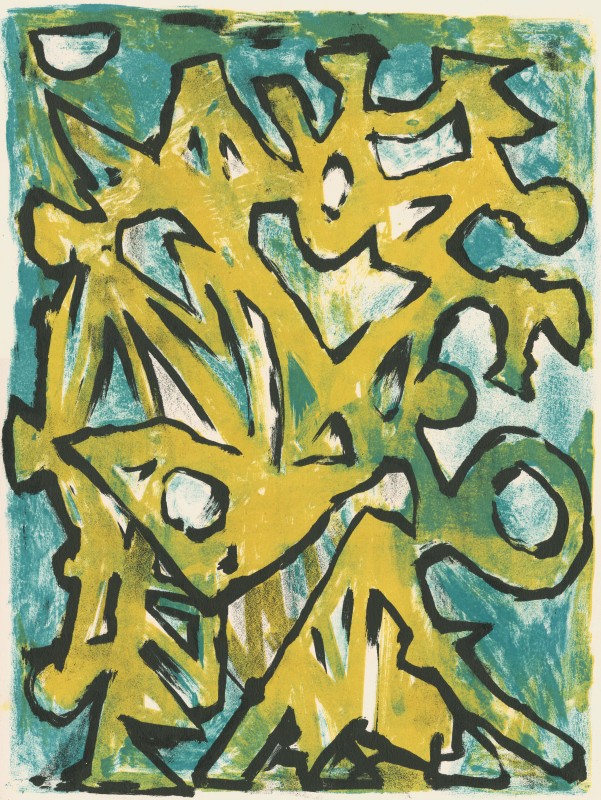 William Gear RAYellow and Green Landscape, 1950Lithograph49 x 37 cm (sheet: 65 x 50 cm)From the edition of 30 impressionsSigned, dated and numbered%3Cdiv%20class%3D%22artist%22%3E%3Cspan%20class%3D%22artist%22%3E%3Cstrong%3EWilliam%20Gear%20RA%3C/strong%3E%3C/span%3E%3C/div%3E%0D%3Cdiv%20class%3D%22title%22%3E%3Cem%3EYellow%20and%20Green%20Landscape%3C/em%3E%2C%201950%3C/div%3E%0D%3Cdiv%20class%3D%22signed_and_dated%22%3ESigned%2C%20dated%20and%20numbered%3C/div%3E%0D%3Cdiv%20class%3D%22medium%22%3ELithograph%3C/div%3E%0D%3Cdiv%20class%3D%22dimensions%22%3E49%20x%2037%20cm%20%28sheet%3A%2065%20x%2050%20cm%29%3C/div%3E%0D%3Cdiv%20class%3D%22edition_details%22%3EFrom%20the%20edition%20of%2030%20impressions%3C/div%3E
William Gear RAYellow and Green Landscape, 1950Lithograph49 x 37 cm (sheet: 65 x 50 cm)From the edition of 30 impressionsSigned, dated and numbered%3Cdiv%20class%3D%22artist%22%3E%3Cspan%20class%3D%22artist%22%3E%3Cstrong%3EWilliam%20Gear%20RA%3C/strong%3E%3C/span%3E%3C/div%3E%0D%3Cdiv%20class%3D%22title%22%3E%3Cem%3EYellow%20and%20Green%20Landscape%3C/em%3E%2C%201950%3C/div%3E%0D%3Cdiv%20class%3D%22signed_and_dated%22%3ESigned%2C%20dated%20and%20numbered%3C/div%3E%0D%3Cdiv%20class%3D%22medium%22%3ELithograph%3C/div%3E%0D%3Cdiv%20class%3D%22dimensions%22%3E49%20x%2037%20cm%20%28sheet%3A%2065%20x%2050%20cm%29%3C/div%3E%0D%3Cdiv%20class%3D%22edition_details%22%3EFrom%20the%20edition%20of%2030%20impressions%3C/div%3E -
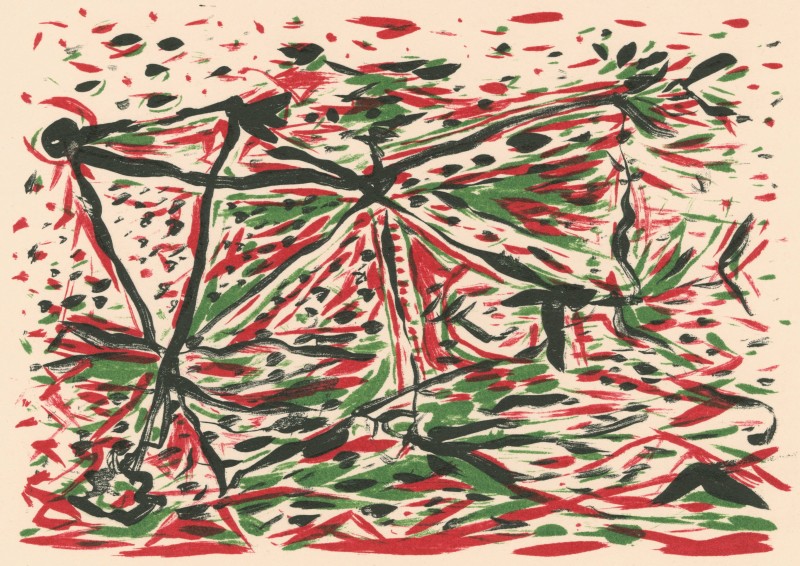 William Gear RAChristmas Landscape, 1949Lithograph16 x 23 cm (sheet: 25 x 33 cm)From the edition of 30 impressionsSigned, dated and numbered%3Cdiv%20class%3D%22artist%22%3E%3Cspan%20class%3D%22artist%22%3E%3Cstrong%3EWilliam%20Gear%20RA%3C/strong%3E%3C/span%3E%3C/div%3E%0D%3Cdiv%20class%3D%22title%22%3E%3Cem%3EChristmas%20Landscape%3C/em%3E%2C%201949%3C/div%3E%0D%3Cdiv%20class%3D%22signed_and_dated%22%3ESigned%2C%20dated%20and%20numbered%3C/div%3E%0D%3Cdiv%20class%3D%22medium%22%3ELithograph%3C/div%3E%0D%3Cdiv%20class%3D%22dimensions%22%3E16%20x%2023%20cm%20%28sheet%3A%2025%20x%2033%20cm%29%3C/div%3E%0D%3Cdiv%20class%3D%22edition_details%22%3EFrom%20the%20edition%20of%2030%20impressions%3C/div%3E
William Gear RAChristmas Landscape, 1949Lithograph16 x 23 cm (sheet: 25 x 33 cm)From the edition of 30 impressionsSigned, dated and numbered%3Cdiv%20class%3D%22artist%22%3E%3Cspan%20class%3D%22artist%22%3E%3Cstrong%3EWilliam%20Gear%20RA%3C/strong%3E%3C/span%3E%3C/div%3E%0D%3Cdiv%20class%3D%22title%22%3E%3Cem%3EChristmas%20Landscape%3C/em%3E%2C%201949%3C/div%3E%0D%3Cdiv%20class%3D%22signed_and_dated%22%3ESigned%2C%20dated%20and%20numbered%3C/div%3E%0D%3Cdiv%20class%3D%22medium%22%3ELithograph%3C/div%3E%0D%3Cdiv%20class%3D%22dimensions%22%3E16%20x%2023%20cm%20%28sheet%3A%2025%20x%2033%20cm%29%3C/div%3E%0D%3Cdiv%20class%3D%22edition_details%22%3EFrom%20the%20edition%20of%2030%20impressions%3C/div%3E -
 William Gear RAStructure in Landscape, 1949Lithograph25 x 39 cmA trial proof, aside from the edition of 25 impressionsSigned, dated and inscribed 'TPI'%3Cdiv%20class%3D%22artist%22%3E%3Cspan%20class%3D%22artist%22%3E%3Cstrong%3EWilliam%20Gear%20RA%3C/strong%3E%3C/span%3E%3C/div%3E%0D%3Cdiv%20class%3D%22title%22%3E%3Cem%3EStructure%20in%20Landscape%3C/em%3E%2C%201949%3C/div%3E%0D%3Cdiv%20class%3D%22signed_and_dated%22%3ESigned%2C%20dated%20and%20inscribed%20%27TPI%27%3C/div%3E%0D%3Cdiv%20class%3D%22medium%22%3ELithograph%3C/div%3E%0D%3Cdiv%20class%3D%22dimensions%22%3E25%20x%2039%20cm%3C/div%3E%0D%3Cdiv%20class%3D%22edition_details%22%3EA%20trial%20proof%2C%20aside%20from%20the%20edition%20of%2025%20impressions%3C/div%3E
William Gear RAStructure in Landscape, 1949Lithograph25 x 39 cmA trial proof, aside from the edition of 25 impressionsSigned, dated and inscribed 'TPI'%3Cdiv%20class%3D%22artist%22%3E%3Cspan%20class%3D%22artist%22%3E%3Cstrong%3EWilliam%20Gear%20RA%3C/strong%3E%3C/span%3E%3C/div%3E%0D%3Cdiv%20class%3D%22title%22%3E%3Cem%3EStructure%20in%20Landscape%3C/em%3E%2C%201949%3C/div%3E%0D%3Cdiv%20class%3D%22signed_and_dated%22%3ESigned%2C%20dated%20and%20inscribed%20%27TPI%27%3C/div%3E%0D%3Cdiv%20class%3D%22medium%22%3ELithograph%3C/div%3E%0D%3Cdiv%20class%3D%22dimensions%22%3E25%20x%2039%20cm%3C/div%3E%0D%3Cdiv%20class%3D%22edition_details%22%3EA%20trial%20proof%2C%20aside%20from%20the%20edition%20of%2025%20impressions%3C/div%3E -
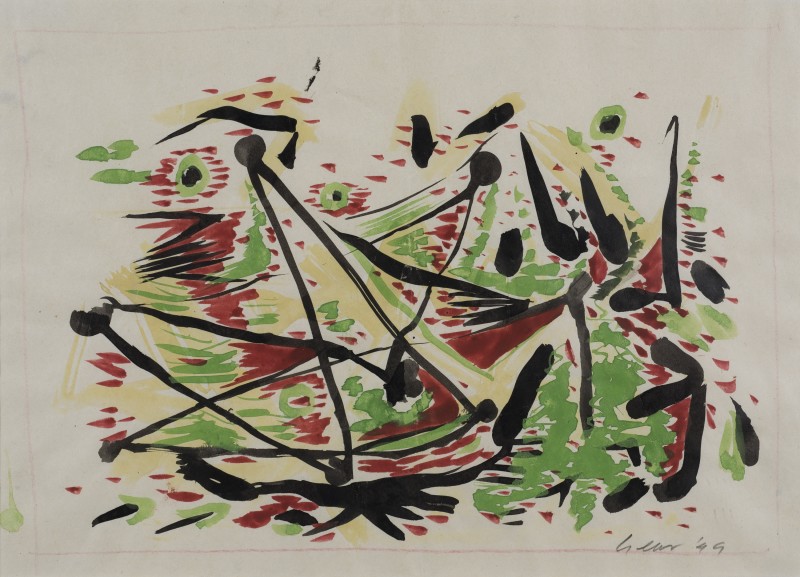 William Gear RAStudy for Lithograph (Christmas Landscape II), 1949Gouache and ink on paper18 x 25 cmSigned and dated lower right%3Cdiv%20class%3D%22artist%22%3E%3Cspan%20class%3D%22artist%22%3E%3Cstrong%3EWilliam%20Gear%20RA%3C/strong%3E%3C/span%3E%3C/div%3E%0D%3Cdiv%20class%3D%22title%22%3E%3Cem%3EStudy%20for%20Lithograph%20%28Christmas%20Landscape%20II%29%3C/em%3E%2C%201949%3C/div%3E%0D%3Cdiv%20class%3D%22signed_and_dated%22%3ESigned%20and%20dated%20lower%20right%3C/div%3E%0D%3Cdiv%20class%3D%22medium%22%3EGouache%20and%20ink%20on%20paper%3C/div%3E%0D%3Cdiv%20class%3D%22dimensions%22%3E18%20x%2025%20cm%3C/div%3E
William Gear RAStudy for Lithograph (Christmas Landscape II), 1949Gouache and ink on paper18 x 25 cmSigned and dated lower right%3Cdiv%20class%3D%22artist%22%3E%3Cspan%20class%3D%22artist%22%3E%3Cstrong%3EWilliam%20Gear%20RA%3C/strong%3E%3C/span%3E%3C/div%3E%0D%3Cdiv%20class%3D%22title%22%3E%3Cem%3EStudy%20for%20Lithograph%20%28Christmas%20Landscape%20II%29%3C/em%3E%2C%201949%3C/div%3E%0D%3Cdiv%20class%3D%22signed_and_dated%22%3ESigned%20and%20dated%20lower%20right%3C/div%3E%0D%3Cdiv%20class%3D%22medium%22%3EGouache%20and%20ink%20on%20paper%3C/div%3E%0D%3Cdiv%20class%3D%22dimensions%22%3E18%20x%2025%20cm%3C/div%3E -
 William Gear RATrees, 1949Lithograph44 x 33 cmFrom the edition of 25 impressionsSigned, dated and numbered%3Cdiv%20class%3D%22artist%22%3E%3Cspan%20class%3D%22artist%22%3E%3Cstrong%3EWilliam%20Gear%20RA%3C/strong%3E%3C/span%3E%3C/div%3E%0D%3Cdiv%20class%3D%22title%22%3E%3Cem%3ETrees%3C/em%3E%2C%201949%3C/div%3E%0D%3Cdiv%20class%3D%22signed_and_dated%22%3ESigned%2C%20dated%20and%20numbered%3C/div%3E%0D%3Cdiv%20class%3D%22medium%22%3ELithograph%3C/div%3E%0D%3Cdiv%20class%3D%22dimensions%22%3E44%20x%2033%20cm%20%3C/div%3E%0D%3Cdiv%20class%3D%22edition_details%22%3EFrom%20the%20edition%20of%2025%20impressions%3C/div%3E
William Gear RATrees, 1949Lithograph44 x 33 cmFrom the edition of 25 impressionsSigned, dated and numbered%3Cdiv%20class%3D%22artist%22%3E%3Cspan%20class%3D%22artist%22%3E%3Cstrong%3EWilliam%20Gear%20RA%3C/strong%3E%3C/span%3E%3C/div%3E%0D%3Cdiv%20class%3D%22title%22%3E%3Cem%3ETrees%3C/em%3E%2C%201949%3C/div%3E%0D%3Cdiv%20class%3D%22signed_and_dated%22%3ESigned%2C%20dated%20and%20numbered%3C/div%3E%0D%3Cdiv%20class%3D%22medium%22%3ELithograph%3C/div%3E%0D%3Cdiv%20class%3D%22dimensions%22%3E44%20x%2033%20cm%20%3C/div%3E%0D%3Cdiv%20class%3D%22edition_details%22%3EFrom%20the%20edition%20of%2025%20impressions%3C/div%3E -
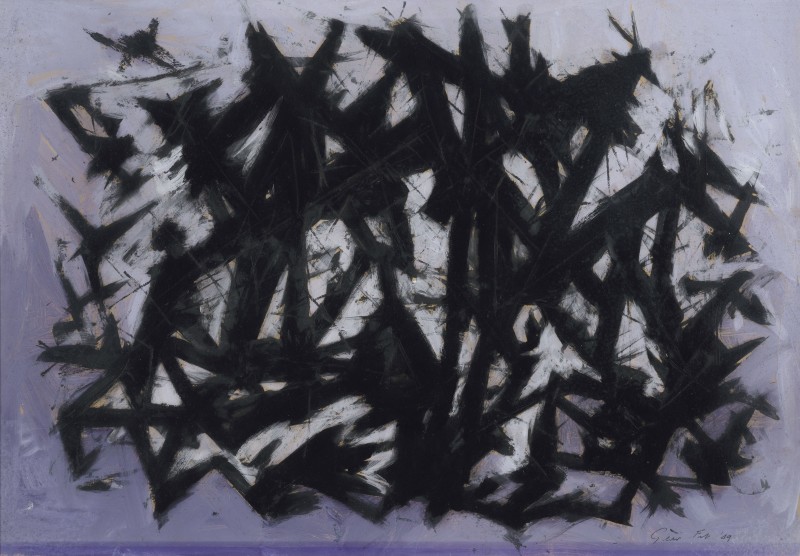 William Gear RAWinter Menace, 1949Gouache and ink on card53 x 74 cmSigned and dated lower right; titled verso%3Cdiv%20class%3D%22artist%22%3E%3Cspan%20class%3D%22artist%22%3E%3Cstrong%3EWilliam%20Gear%20RA%3C/strong%3E%3C/span%3E%3C/div%3E%0D%3Cdiv%20class%3D%22title%22%3E%3Cem%3EWinter%20Menace%3C/em%3E%2C%201949%3C/div%3E%0D%3Cdiv%20class%3D%22signed_and_dated%22%3ESigned%20and%20dated%20lower%20right%3B%20titled%20verso%3C/div%3E%0D%3Cdiv%20class%3D%22medium%22%3EGouache%20and%20ink%20on%20card%3C/div%3E%0D%3Cdiv%20class%3D%22dimensions%22%3E53%20x%2074%20cm%3C/div%3E
William Gear RAWinter Menace, 1949Gouache and ink on card53 x 74 cmSigned and dated lower right; titled verso%3Cdiv%20class%3D%22artist%22%3E%3Cspan%20class%3D%22artist%22%3E%3Cstrong%3EWilliam%20Gear%20RA%3C/strong%3E%3C/span%3E%3C/div%3E%0D%3Cdiv%20class%3D%22title%22%3E%3Cem%3EWinter%20Menace%3C/em%3E%2C%201949%3C/div%3E%0D%3Cdiv%20class%3D%22signed_and_dated%22%3ESigned%20and%20dated%20lower%20right%3B%20titled%20verso%3C/div%3E%0D%3Cdiv%20class%3D%22medium%22%3EGouache%20and%20ink%20on%20card%3C/div%3E%0D%3Cdiv%20class%3D%22dimensions%22%3E53%20x%2074%20cm%3C/div%3E -
 William Gear RALandscape, 1948Gouache on paper44 x 56 cmSigned and dated lower right; titled verso%3Cdiv%20class%3D%22artist%22%3E%3Cspan%20class%3D%22artist%22%3E%3Cstrong%3EWilliam%20Gear%20RA%3C/strong%3E%3C/span%3E%3C/div%3E%0D%3Cdiv%20class%3D%22title%22%3E%3Cem%3ELandscape%3C/em%3E%2C%201948%3C/div%3E%0D%3Cdiv%20class%3D%22signed_and_dated%22%3ESigned%20and%20dated%20lower%20right%3B%20titled%20verso%3C/div%3E%0D%3Cdiv%20class%3D%22medium%22%3EGouache%20on%20paper%3C/div%3E%0D%3Cdiv%20class%3D%22dimensions%22%3E44%20x%2056%20cm%3C/div%3E
William Gear RALandscape, 1948Gouache on paper44 x 56 cmSigned and dated lower right; titled verso%3Cdiv%20class%3D%22artist%22%3E%3Cspan%20class%3D%22artist%22%3E%3Cstrong%3EWilliam%20Gear%20RA%3C/strong%3E%3C/span%3E%3C/div%3E%0D%3Cdiv%20class%3D%22title%22%3E%3Cem%3ELandscape%3C/em%3E%2C%201948%3C/div%3E%0D%3Cdiv%20class%3D%22signed_and_dated%22%3ESigned%20and%20dated%20lower%20right%3B%20titled%20verso%3C/div%3E%0D%3Cdiv%20class%3D%22medium%22%3EGouache%20on%20paper%3C/div%3E%0D%3Cdiv%20class%3D%22dimensions%22%3E44%20x%2056%20cm%3C/div%3E -
 William Gear RAComposition, 1947Oil on paper laid on canvas38 x 65 cmSigned and dated lower right%3Cdiv%20class%3D%22artist%22%3E%3Cspan%20class%3D%22artist%22%3E%3Cstrong%3EWilliam%20Gear%20RA%3C/strong%3E%3C/span%3E%3C/div%3E%0D%3Cdiv%20class%3D%22title%22%3E%3Cem%3EComposition%3C/em%3E%2C%201947%3C/div%3E%0D%3Cdiv%20class%3D%22signed_and_dated%22%3ESigned%20and%20dated%20lower%20right%3C/div%3E%0D%3Cdiv%20class%3D%22medium%22%3EOil%20on%20paper%20laid%20on%20canvas%3C/div%3E%0D%3Cdiv%20class%3D%22dimensions%22%3E38%20x%2065%20cm%3C/div%3E
William Gear RAComposition, 1947Oil on paper laid on canvas38 x 65 cmSigned and dated lower right%3Cdiv%20class%3D%22artist%22%3E%3Cspan%20class%3D%22artist%22%3E%3Cstrong%3EWilliam%20Gear%20RA%3C/strong%3E%3C/span%3E%3C/div%3E%0D%3Cdiv%20class%3D%22title%22%3E%3Cem%3EComposition%3C/em%3E%2C%201947%3C/div%3E%0D%3Cdiv%20class%3D%22signed_and_dated%22%3ESigned%20and%20dated%20lower%20right%3C/div%3E%0D%3Cdiv%20class%3D%22medium%22%3EOil%20on%20paper%20laid%20on%20canvas%3C/div%3E%0D%3Cdiv%20class%3D%22dimensions%22%3E38%20x%2065%20cm%3C/div%3E -
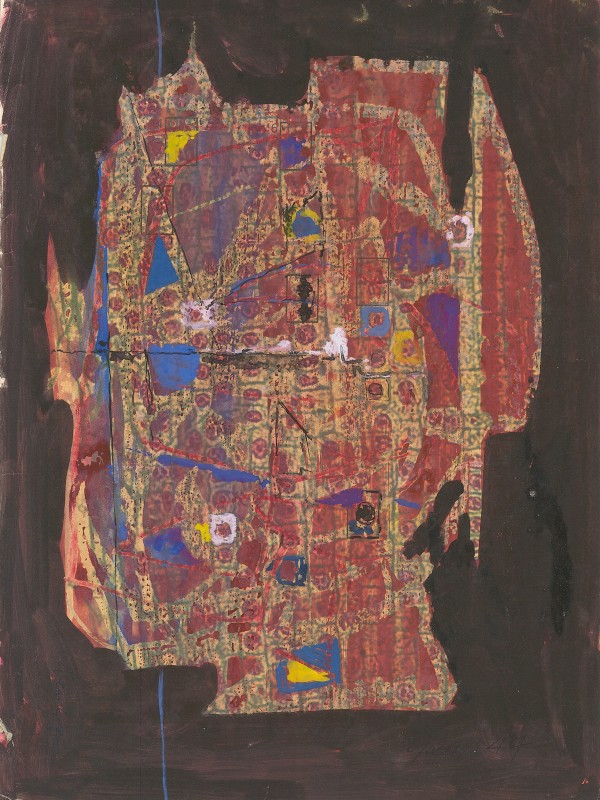 William Gear RATete Fantastique, 1947Gouache on printed media35 x 26 cmSigned and dated lower right; titled verso%3Cdiv%20class%3D%22artist%22%3E%3Cspan%20class%3D%22artist%22%3E%3Cstrong%3EWilliam%20Gear%20RA%3C/strong%3E%3C/span%3E%3C/div%3E%0D%3Cdiv%20class%3D%22title%22%3E%3Cem%3ETete%20Fantastique%3C/em%3E%2C%201947%3C/div%3E%0D%3Cdiv%20class%3D%22signed_and_dated%22%3ESigned%20and%20dated%20lower%20right%3B%20titled%20verso%3C/div%3E%0D%3Cdiv%20class%3D%22medium%22%3EGouache%20on%20printed%20media%3C/div%3E%0D%3Cdiv%20class%3D%22dimensions%22%3E35%20x%2026%20cm%3C/div%3E
William Gear RATete Fantastique, 1947Gouache on printed media35 x 26 cmSigned and dated lower right; titled verso%3Cdiv%20class%3D%22artist%22%3E%3Cspan%20class%3D%22artist%22%3E%3Cstrong%3EWilliam%20Gear%20RA%3C/strong%3E%3C/span%3E%3C/div%3E%0D%3Cdiv%20class%3D%22title%22%3E%3Cem%3ETete%20Fantastique%3C/em%3E%2C%201947%3C/div%3E%0D%3Cdiv%20class%3D%22signed_and_dated%22%3ESigned%20and%20dated%20lower%20right%3B%20titled%20verso%3C/div%3E%0D%3Cdiv%20class%3D%22medium%22%3EGouache%20on%20printed%20media%3C/div%3E%0D%3Cdiv%20class%3D%22dimensions%22%3E35%20x%2026%20cm%3C/div%3E -
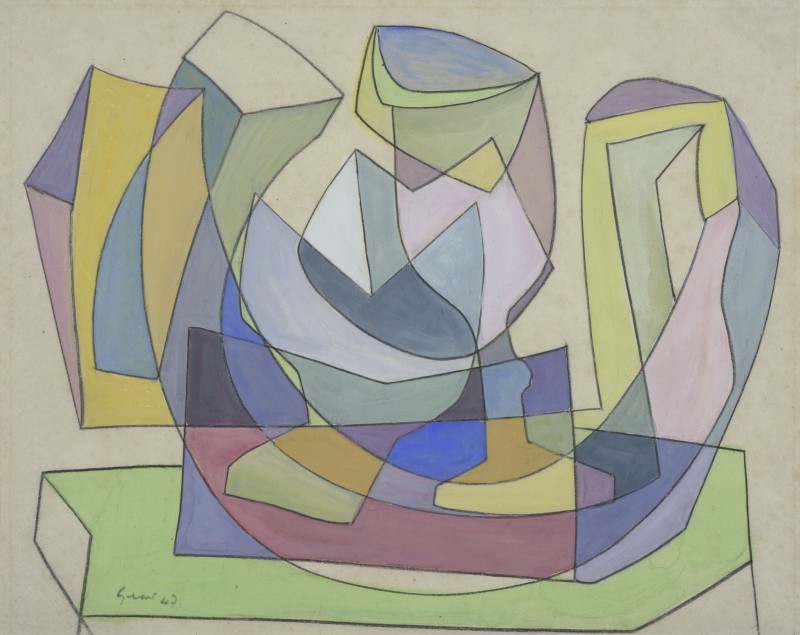 William Gear RAUntitled, 1947Gouache and pencil on paper42 x 50 cmSigned and dated lower left%3Cdiv%20class%3D%22artist%22%3E%3Cspan%20class%3D%22artist%22%3E%3Cstrong%3EWilliam%20Gear%20RA%3C/strong%3E%3C/span%3E%3C/div%3E%0D%3Cdiv%20class%3D%22title%22%3E%3Cem%3EUntitled%3C/em%3E%2C%201947%3C/div%3E%0D%3Cdiv%20class%3D%22signed_and_dated%22%3ESigned%20and%20dated%20lower%20left%3C/div%3E%0D%3Cdiv%20class%3D%22medium%22%3EGouache%20and%20pencil%20on%20paper%3C/div%3E%0D%3Cdiv%20class%3D%22dimensions%22%3E42%20x%2050%20cm%3C/div%3E
William Gear RAUntitled, 1947Gouache and pencil on paper42 x 50 cmSigned and dated lower left%3Cdiv%20class%3D%22artist%22%3E%3Cspan%20class%3D%22artist%22%3E%3Cstrong%3EWilliam%20Gear%20RA%3C/strong%3E%3C/span%3E%3C/div%3E%0D%3Cdiv%20class%3D%22title%22%3E%3Cem%3EUntitled%3C/em%3E%2C%201947%3C/div%3E%0D%3Cdiv%20class%3D%22signed_and_dated%22%3ESigned%20and%20dated%20lower%20left%3C/div%3E%0D%3Cdiv%20class%3D%22medium%22%3EGouache%20and%20pencil%20on%20paper%3C/div%3E%0D%3Cdiv%20class%3D%22dimensions%22%3E42%20x%2050%20cm%3C/div%3E -
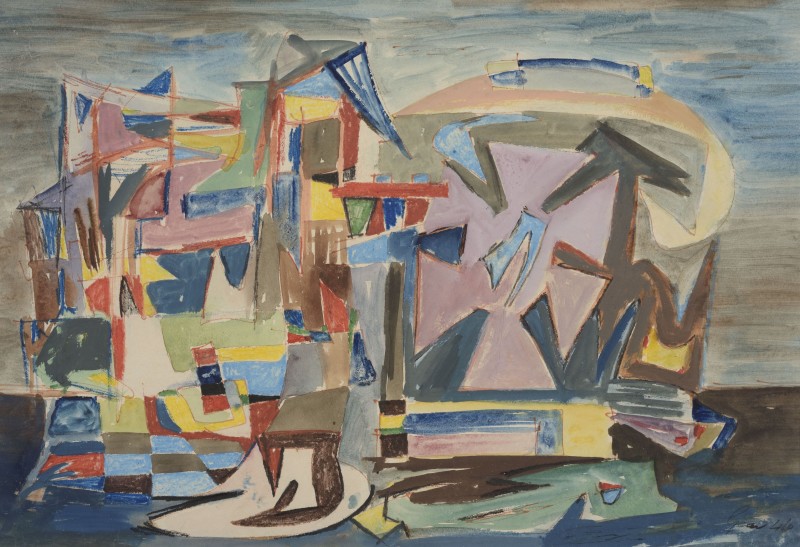 William Gear RAComposition, 1944Gouache on paper34 x 49 cmSigned and dated lower right%3Cdiv%20class%3D%22artist%22%3E%3Cspan%20class%3D%22artist%22%3E%3Cstrong%3EWilliam%20Gear%20RA%3C/strong%3E%3C/span%3E%3C/div%3E%0D%3Cdiv%20class%3D%22title%22%3E%3Cem%3EComposition%3C/em%3E%2C%201944%3C/div%3E%0D%3Cdiv%20class%3D%22signed_and_dated%22%3ESigned%20and%20dated%20lower%20right%3C/div%3E%0D%3Cdiv%20class%3D%22medium%22%3EGouache%20on%20paper%3C/div%3E%0D%3Cdiv%20class%3D%22dimensions%22%3E34%20x%2049%20cm%3C/div%3E
William Gear RAComposition, 1944Gouache on paper34 x 49 cmSigned and dated lower right%3Cdiv%20class%3D%22artist%22%3E%3Cspan%20class%3D%22artist%22%3E%3Cstrong%3EWilliam%20Gear%20RA%3C/strong%3E%3C/span%3E%3C/div%3E%0D%3Cdiv%20class%3D%22title%22%3E%3Cem%3EComposition%3C/em%3E%2C%201944%3C/div%3E%0D%3Cdiv%20class%3D%22signed_and_dated%22%3ESigned%20and%20dated%20lower%20right%3C/div%3E%0D%3Cdiv%20class%3D%22medium%22%3EGouache%20on%20paper%3C/div%3E%0D%3Cdiv%20class%3D%22dimensions%22%3E34%20x%2049%20cm%3C/div%3E -
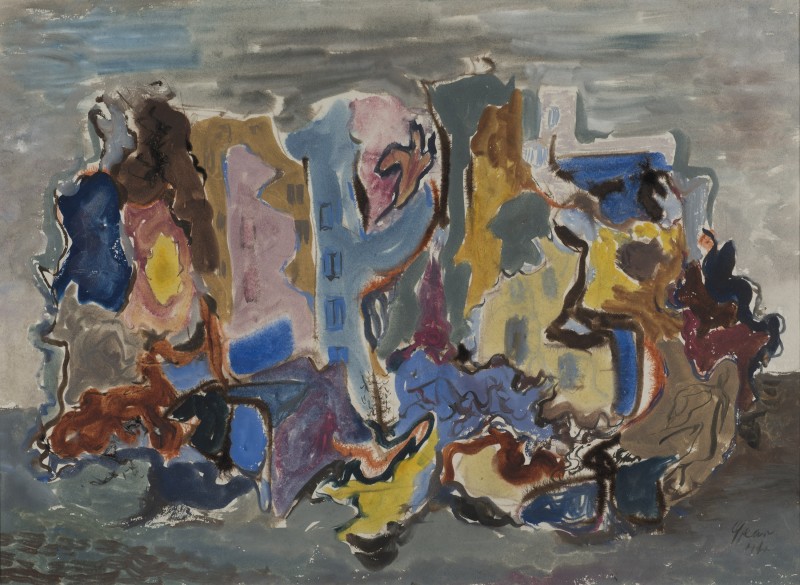 William Gear RARuins, Rovinazioni, 1944Watercolour on paper35 x 48 cmSigned and dated lower right; titled verso%3Cdiv%20class%3D%22artist%22%3E%3Cspan%20class%3D%22artist%22%3E%3Cstrong%3EWilliam%20Gear%20RA%3C/strong%3E%3C/span%3E%3C/div%3E%0D%3Cdiv%20class%3D%22title%22%3E%3Cem%3ERuins%2C%20Rovinazioni%3C/em%3E%2C%201944%3C/div%3E%0D%3Cdiv%20class%3D%22signed_and_dated%22%3ESigned%20and%20dated%20lower%20right%3B%20titled%20verso%3C/div%3E%0D%3Cdiv%20class%3D%22medium%22%3EWatercolour%20on%20paper%3C/div%3E%0D%3Cdiv%20class%3D%22dimensions%22%3E35%20x%2048%20cm%3C/div%3E
William Gear RARuins, Rovinazioni, 1944Watercolour on paper35 x 48 cmSigned and dated lower right; titled verso%3Cdiv%20class%3D%22artist%22%3E%3Cspan%20class%3D%22artist%22%3E%3Cstrong%3EWilliam%20Gear%20RA%3C/strong%3E%3C/span%3E%3C/div%3E%0D%3Cdiv%20class%3D%22title%22%3E%3Cem%3ERuins%2C%20Rovinazioni%3C/em%3E%2C%201944%3C/div%3E%0D%3Cdiv%20class%3D%22signed_and_dated%22%3ESigned%20and%20dated%20lower%20right%3B%20titled%20verso%3C/div%3E%0D%3Cdiv%20class%3D%22medium%22%3EWatercolour%20on%20paper%3C/div%3E%0D%3Cdiv%20class%3D%22dimensions%22%3E35%20x%2048%20cm%3C/div%3E -
 William Gear RASea Monster, 1941Watercolour on paper29 x 45 cmSigned and dated lower left; titled verso%3Cdiv%20class%3D%22artist%22%3E%3Cspan%20class%3D%22artist%22%3E%3Cstrong%3EWilliam%20Gear%20RA%3C/strong%3E%3C/span%3E%3C/div%3E%0D%3Cdiv%20class%3D%22title%22%3E%3Cem%3ESea%20Monster%3C/em%3E%2C%201941%3C/div%3E%0D%3Cdiv%20class%3D%22signed_and_dated%22%3ESigned%20and%20dated%20lower%20left%3B%20titled%20verso%3C/div%3E%0D%3Cdiv%20class%3D%22medium%22%3EWatercolour%20on%20paper%3C/div%3E%0D%3Cdiv%20class%3D%22dimensions%22%3E29%20x%2045%20cm%3C/div%3E
William Gear RASea Monster, 1941Watercolour on paper29 x 45 cmSigned and dated lower left; titled verso%3Cdiv%20class%3D%22artist%22%3E%3Cspan%20class%3D%22artist%22%3E%3Cstrong%3EWilliam%20Gear%20RA%3C/strong%3E%3C/span%3E%3C/div%3E%0D%3Cdiv%20class%3D%22title%22%3E%3Cem%3ESea%20Monster%3C/em%3E%2C%201941%3C/div%3E%0D%3Cdiv%20class%3D%22signed_and_dated%22%3ESigned%20and%20dated%20lower%20left%3B%20titled%20verso%3C/div%3E%0D%3Cdiv%20class%3D%22medium%22%3EWatercolour%20on%20paper%3C/div%3E%0D%3Cdiv%20class%3D%22dimensions%22%3E29%20x%2045%20cm%3C/div%3E -
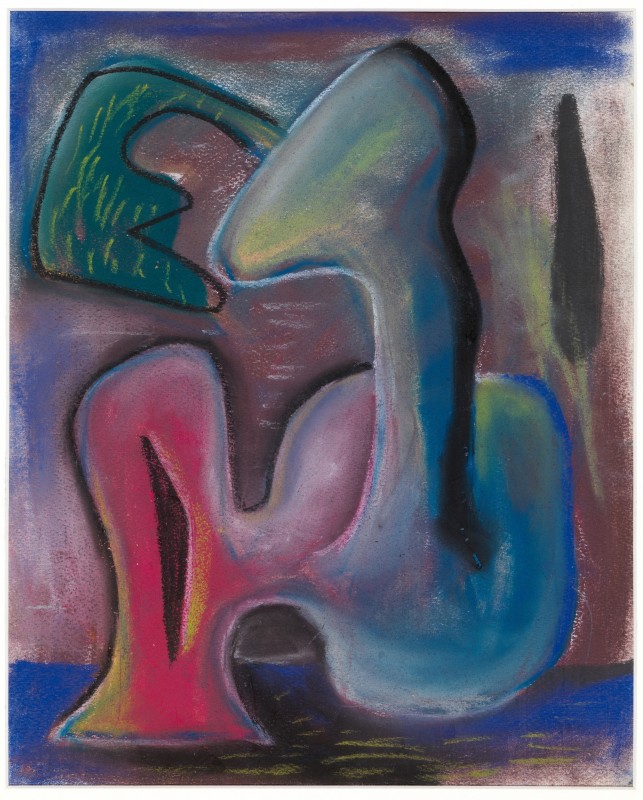 William Gear RAUntitled (Surrealist Forms), 1938 (c.)Pastel on paper37 x 29 cm%3Cdiv%20class%3D%22artist%22%3E%3Cspan%20class%3D%22artist%22%3E%3Cstrong%3EWilliam%20Gear%20RA%3C/strong%3E%3C/span%3E%3C/div%3E%0D%3Cdiv%20class%3D%22title%22%3E%3Cem%3EUntitled%20%28Surrealist%20Forms%29%3C/em%3E%2C%201938%20%28c.%29%3C/div%3E%0D%3Cdiv%20class%3D%22medium%22%3EPastel%20on%20paper%3C/div%3E%0D%3Cdiv%20class%3D%22dimensions%22%3E37%20x%2029%20cm%3C/div%3E
William Gear RAUntitled (Surrealist Forms), 1938 (c.)Pastel on paper37 x 29 cm%3Cdiv%20class%3D%22artist%22%3E%3Cspan%20class%3D%22artist%22%3E%3Cstrong%3EWilliam%20Gear%20RA%3C/strong%3E%3C/span%3E%3C/div%3E%0D%3Cdiv%20class%3D%22title%22%3E%3Cem%3EUntitled%20%28Surrealist%20Forms%29%3C/em%3E%2C%201938%20%28c.%29%3C/div%3E%0D%3Cdiv%20class%3D%22medium%22%3EPastel%20on%20paper%3C/div%3E%0D%3Cdiv%20class%3D%22dimensions%22%3E37%20x%2029%20cm%3C/div%3E
